🔥5 Powerful Symbols Bhikaji Cama Used to Ignite National Pride
🧠 Introduction: Bhikaji Cama: The Flame That Lit India’s Flag Before It Was Born
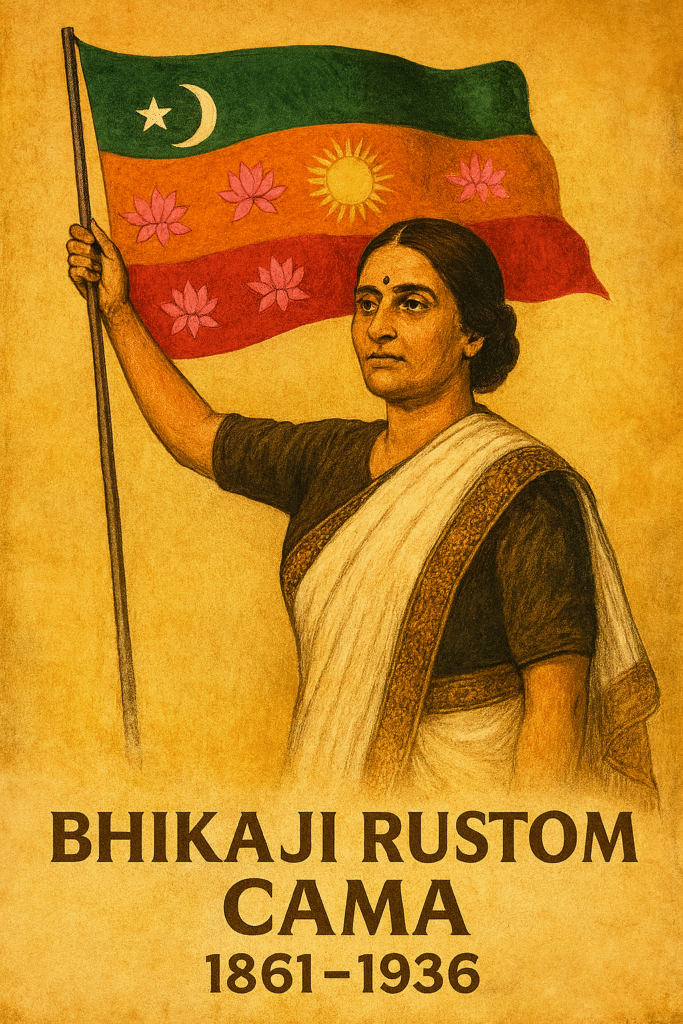
In the vast chronicle of India’s freedom struggle, few names evoke the quiet intensity of Bhikaji Cama. She wasn’t a battlefield warrior, nor a mass movement leader—but her impact was global, her courage unshakable, and her legacy immortal. Bhikaji Cama stood at the intersection of diplomacy, revolution, and symbolism, becoming the first Indian to unfurl a national flag on foreign soil. Her story is one of exile turned into activism, silence turned into strategy, and a woman’s voice rising above empires.
Born on 24 September 1861 in Navsari, Bombay Presidency, Bhikaji Cama was raised in a progressive Parsi household that valued education, reform, and service. Her father, Sorabji Framji Patel, was a wealthy merchant and a supporter of social causes. From her early years, Bhikaji Cama absorbed the ideals of justice and equality—values that would later shape her revolutionary path.
Educated at the Alexandra Girls’ English Institution, Bhikaji Cama was known for her intellect and eloquence. In 1885, she married Rustom Cama, a prominent lawyer and social worker. However, the marriage was strained by ideological differences. While Rustom leaned toward British loyalty, Bhikaji Cama’s heart beat for India’s independence. This divergence would define her future.
Her transformation began during the plague epidemic in Bombay in 1896. Bhikaji Cama volunteered tirelessly, tending to the sick and organizing relief efforts. In the process, she contracted the disease herself. Her recovery took her to London, where she encountered the intellectual firebrands of India’s nationalist movement—Dadabhai Naoroji, Shyamji Krishna Varma, and Veer Savarkar. These meetings ignited a deeper purpose: Bhikaji Cama would not merely support the cause—she would become its voice abroad.
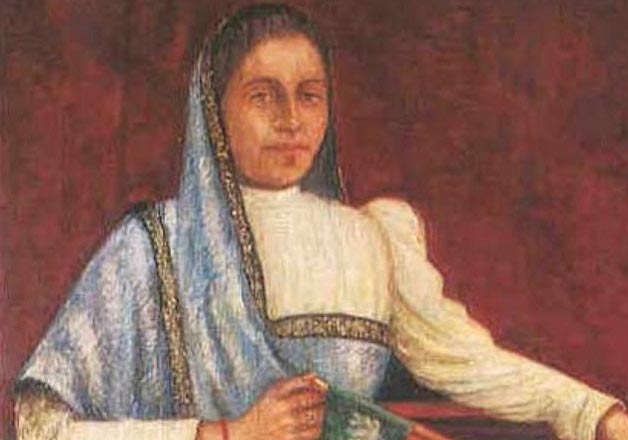
In 1905, Bhikaji Cama moved to Paris to escape British surveillance. There, she co-founded the Paris Indian Society, a hub for exiled revolutionaries. She began publishing revolutionary literature like Bande Mataram and Madan’s Talwar, smuggling them into India to awaken the masses. Her pen became her weapon, her words a rallying cry for freedom.
But her most iconic moment came on 22 August 1907, at the International Socialist Congress in Stuttgart, Germany. Standing before delegates from across the world, Bhikaji Cama unfurled a tricolor flag—green, saffron, and red—with eight lotuses representing India’s provinces and the words “Vande Mataram” inscribed. She declared:
“This is the flag of Indian independence. I appeal to all present to rise and salute it.”
It was a moment of defiance, dignity, and diplomatic brilliance. Bhikaji Cama had taken India’s struggle to the global stage, demanding recognition and solidarity.
For the next several years, Bhikaji Cama remained in Europe, tirelessly advocating for India’s freedom. She collaborated with socialist groups, supported revolutionaries financially, and challenged colonial narratives in international forums. Her home in Paris became a sanctuary for freedom fighters, her life a symbol of resistance.
With the outbreak of World War I in 1914, Bhikaji Cama’s movements were restricted. Under pressure from the British, France placed her under surveillance. Though her public activism waned, her spirit remained unbroken. Bhikaji Cama continued to mentor and fund the movement from behind closed doors.
After 33 years in exile, Bhikaji Cama was finally allowed to return to India in 1935, on the condition that she would abstain from political activity. She returned to Bombay, frail but fulfilled, and spent her final days in the Parsi General Hospital. On 13 August 1936, Bhikaji Cama passed away—quietly, without fanfare, but leaving behind a legacy that refuses to be forgotten.
Bhikaji Cama’s story is not just one of rebellion—it’s one of resilience, intellect, and global impact. She challenged gender norms, colonial power, and nationalist apathy. She proved that revolution isn’t confined to borders, and that a single voice, when armed with conviction, can echo across continents.
Today, as India reclaims its historical narratives, Bhikaji Cama’s name resurfaces—not as a footnote, but as a flame. Her life reminds us that patriotism is not just about fighting—it’s about believing, building, and bearing the weight of a nation’s dreams. Bhikaji Cama was the mother of India’s international resistance, and her legacy deserves to be etched in every classroom, every flag, and every heart that beats for freedom.
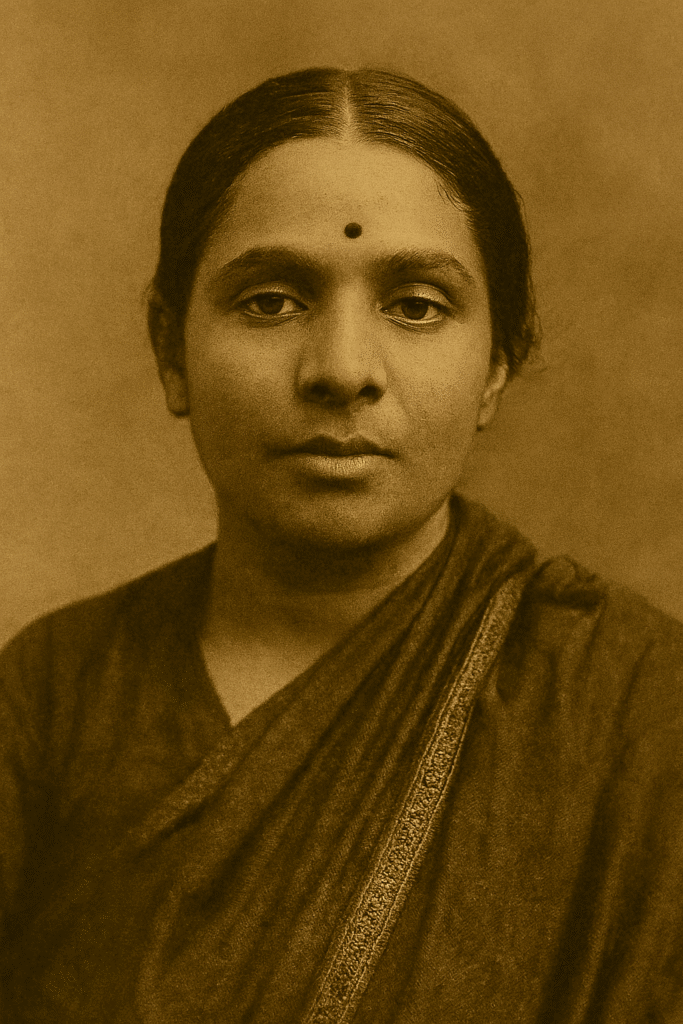
Bhikaji Cama’s courage, intellect, and unwavering commitment to India’s sovereignty make her a timeless icon. Her name, once whispered in exile, now echoes in the halls of history. And as we salute the tricolor today, we must remember the woman who first raised it—not in celebration, but in protest. That woman was Bhikaji Cama.
Table of Contents
🏁 “The Flag of Indian Independence”
📍 Location: Stuttgart, Germany
🗓️ Date: August 22, 1907
🎯 Motive: To expose British colonial exploitation and rally international socialist support for India’s freedom
👥 Crowd: Over 1,000 delegates from 37 nations, including European socialist leaders, labor activists, and anti-imperialist thinkers
🗣️Speech-
“Gentlemen,
I rise today not as a citizen of a free nation, but as a daughter of a land shackled by foreign rule. India, my motherland, groans under the weight of British imperialism. Her sons and daughters toil in poverty, her resources are plundered, her voice silenced.
I bring to you today the Flag of Indian Independence—a symbol not just of resistance, but of hope. This flag bears the colors of unity, the lotus of purity, the sun of strength, and the crescent of faith. It represents the soul of India, yearning to breathe free.
I appeal to you, comrades in the cause of liberty, to stand and salute this flag. Not for me, but for the millions who suffer in silence. Let this Congress be the first to recognize India’s right to self-rule.
The struggle for freedom is not confined to borders. It is a universal cry. And today, that cry comes from India.
Long live revolution. Long live freedom. Long live India.”
🎯 Motive:
- To internationalize India’s independence struggle
- To expose British colonial exploitation
- To rally socialist solidarity for India’s self-rule
- To unveil the first Indian flag on foreign soil
📍1861 – Birth and Early Life
🔶 A Daughter Born to Destiny
24 September 1861 — In the quiet town of Navsari, nestled within the Bombay Presidency (now Gujarat), a child was born who would one day raise the voice of India on foreign soil. Her name: Bhikaji Sorab Patel, later known to history as Madam Bhikaji Cama.
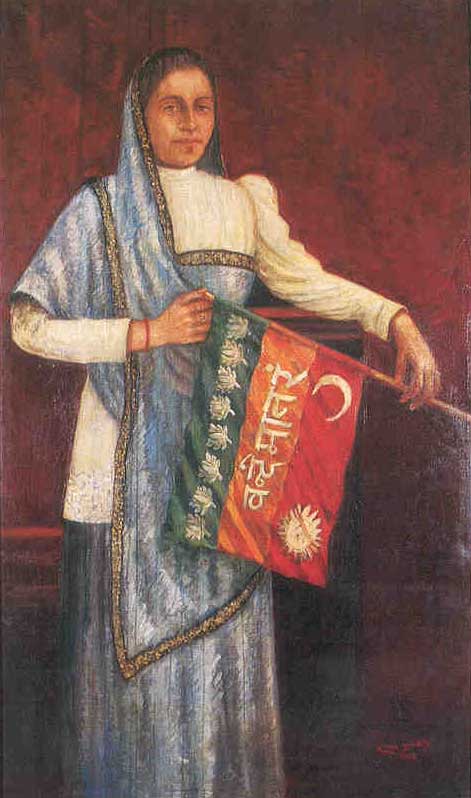
She was born into a wealthy and influential Parsi family, a community known for its progressive values, philanthropy, and fierce commitment to education. Her father, Sorabji Framji Patel, was a respected merchant and reformer whose civic contributions shaped Bombay’s social landscape. But Bhikaji was not destined to live a life of comfort alone—she was born into privilege, yes, but also into purpose.
“She was not just born into a home—she was born into a movement waiting to happen.”
🔶 Bombay Presidency: A Cradle of Reform
The Bombay Presidency in the mid-19th century was a melting pot of ideas, resistance, and reform. It was here that Dadabhai Naoroji spoke of economic drain, Gopal Krishna Gokhale debated justice, and women’s education began to take root. Bhikaji’s upbringing was steeped in this atmosphere of awakening.
Her family’s Parsi heritage played a crucial role. The Parsis, though a minority, were among the first to embrace Western education, industrial enterprise, and social reform. They believed in balancing tradition with progress—a philosophy that Bhikaji would carry into her revolutionary years.
🔶 Alexandra Girls’ English Institution: The First Spark
Bhikaji’s formal education began at the Alexandra Girls’ English Institution in Mumbai, one of the few schools at the time that welcomed girls into its classrooms. This was not just a school—it was a sanctuary of ideas, a place where young women were taught to think, speak, and lead.
Here, Bhikaji learned English, Gujarati, and Marathi. She studied literature, history, and the early stirrings of political thought. But more than subjects, she absorbed confidence, clarity, and conviction.
“In a world that silenced women, her education gave her a voice—and she would use it to shake empires.”
Her time at Alexandra Girls’ was transformative. It exposed her to Indian reformers, British liberal thinkers, and the global language of resistance. She began to question colonial narratives, challenge gender roles, and imagine a future where India stood free.
🔶 A Progressive Household: Reform in the Blood
Bhikaji’s home was not just wealthy—it was ideologically rich. Her parents encouraged debate, reading, and civic engagement. They supported social causes, funded educational initiatives, and believed that women deserved equal footing in society.
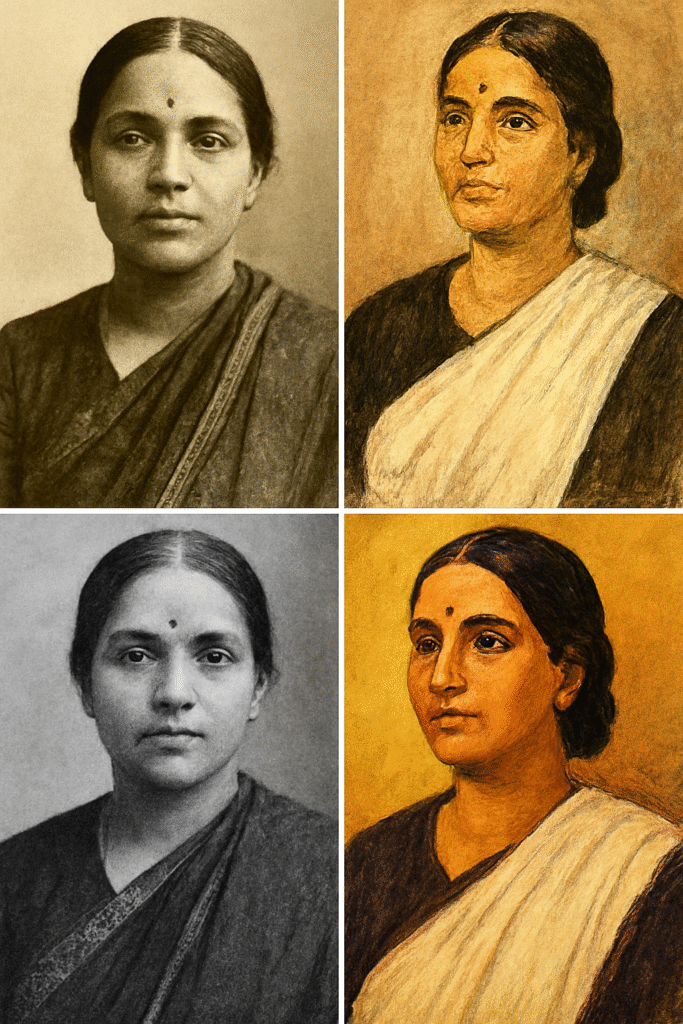
This environment shaped Bhikaji’s worldview. She grew up watching her father engage with municipal reforms, her mother support charitable causes, and her community fight for justice and dignity.
“She didn’t inherit wealth—she inherited a legacy of reform.”
From an early age, Bhikaji was drawn to the stories of Rani Lakshmibai, Sarojini Naidu, and Dadabhai Naoroji. She saw herself not just as a daughter of Navsari, but as a daughter of India, destined to serve a cause larger than herself.
🔶 Seeds of Revolution: The Inner Fire
By the time Bhikaji reached her late teens, the Indian nationalist movement was beginning to stir. Newspapers carried stories of British exploitation, economic drain, and calls for swaraj. Bhikaji read them all, discussed them at home, and began to form her own ideas.
She was especially influenced by Dadabhai Naoroji’s Drain Theory, which argued that Britain was siphoning India’s wealth. This theory would later become a cornerstone of her speeches abroad.
But her fire was not just intellectual—it was emotional. She felt the pain of her people, the humiliation of colonial rule, and the urgency of action.
“She was not waiting for a revolution—she was preparing to become one.”
🔶 Conclusion: The Making of a Revolutionary
The year 1861 was not just the birth of Bhikaji Cama—it was the birth of a new kind of Indian woman. Educated, empowered, and unafraid. Her early life was a blueprint for the fire she would later unleash across Europe, waving the Indian flag in defiance of empire.
In the chapters that follow, we’ll trace her journey from plague relief in Bombay to flag-waving in Stuttgart, from Paris propaganda to her final return to India.
But it all began here—in Navsari, in Bombay, in the classrooms of Alexandra Girls’ Institution. Where a girl became a voice. And that voice became a revolution.
💍 1885 – The Marriage That Forged a Revolutionary
🔶 The Year That Changed Her Path
In the year 1885, a young woman from Bombay’s elite Parsi community stood at the crossroads of tradition and transformation. Her name was Bhikaji Cama. Born into privilege, educated with precision, and raised in a household that valued reform, she was expected to follow the path of quiet dignity. But destiny had other plans.
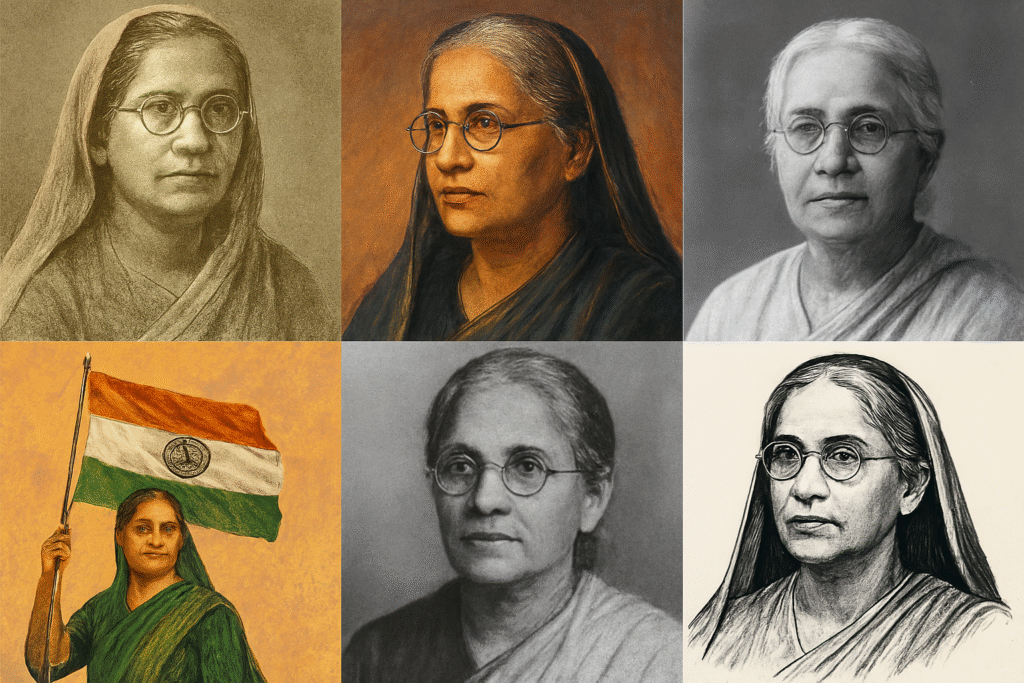
That year, Bhikaji Cama married Rustom Cama, a prominent lawyer and social worker. The union was celebrated among Bombay’s upper circles—a match of intellect, wealth, and social standing. Yet beneath the surface, it was a collision of two worlds. One loyal to the British Empire. The other burning for Indian freedom.
🔶 Who Was Rustom Cama?
Rustom Cama was a man of stature. A respected legal mind, a civic contributor, and a product of colonial Bombay’s elite. He believed in gradual reform, legal order, and cooperation with the British administration. His worldview was shaped by law books, courtroom debates, and the belief that India’s progress lay in partnership with the Empire.
To many, he was the ideal Parsi gentleman—refined, rational, and loyal. But to Bhikaji Cama, his loyalty came at a cost. It meant silence in the face of injustice. It meant compromise when the nation needed courage.
“She married a man of law, but her soul belonged to liberty.”
🔶 Bhikaji Cama: A Fire Within
Even before her marriage, Bhikaji Cama had shown signs of awakening. Her education at the Alexandra Girls’ English Institution had exposed her to the writings of reformers, the speeches of early nationalists, and the pain of colonial exploitation. She read about India’s economic drain, women’s rights, and the struggles of the poor.
She was especially influenced by Dadabhai Naoroji, whose ideas on British economic exploitation stirred her conscience. While others debated, Bhikaji Cama felt. She felt the humiliation of her people, the urgency of action, and the need to speak—even if it meant standing alone.
“Her heart beat for India long before her voice echoed across Europe.”
🔶 A Home Divided by Ideology
The marriage between Bhikaji Cama and Rustom Cama was not a failure—it was a forge. It tested her beliefs, sharpened her resolve, and revealed the cost of silence. Their home became a battlefield of ideas. Rustom quoted law; Bhikaji Cama quoted liberty. He believed in diplomacy; she believed in defiance.
While Rustom attended colonial functions, Bhikaji Cama attended reformist meetings. While he praised British governance, she questioned its morality. The ideological rift grew wider with each passing year.
“She didn’t leave the marriage—but she left the silence.”
🔶 The Personal Became Political
For Bhikaji Cama, the tension at home mirrored the tension in India. Just as she felt confined by domestic expectations, India was confined by colonial rule. Her personal struggle became a metaphor for the nation’s fight—a woman trapped in a system that refused to change.
She began to withdraw from domestic life and immerse herself in political literature, social service, and nationalist correspondence. Her home was no longer her world. Her world was India—and India needed her voice.
“She chose the path of resistance, even if it meant walking alone.”
🔶 The Turning Point: Plague and Exile
In 1896, when the bubonic plague struck Bombay, Bhikaji Cama volunteered to help victims. Her selfless service led to her contracting the disease. She was sent to Britain for treatment, but this journey became her rebirth.
In London, she met exiled nationalists like Dadabhai Naoroji and Shyamji Krishna Varma. She began attending political meetings, writing articles, and supporting underground publications. Her marriage faded into the background. Her identity as a revolutionary took center stage.
“She left Bombay as a wife. She returned to history as a warrior.”
🔶 Why This Chapter Matters
The year 1885 was not just about marriage—it was about metamorphosis. It was the year Bhikaji Cama stepped into a role that would define her legacy. She didn’t rebel with noise—she rebelled with purpose. She didn’t abandon tradition—she redefined it.
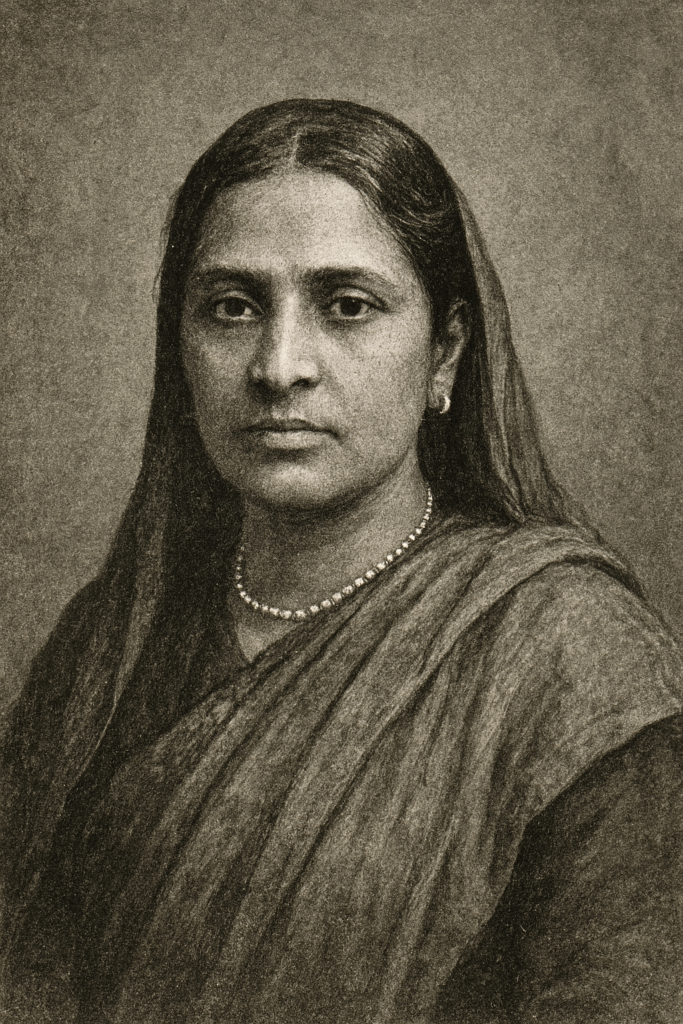
Her marriage to Rustom Cama was a crucible. It tested her fire, refined her ideology, and prepared her for the battles ahead. In a society that expected women to conform, Bhikaji Cama chose to confront. In a home that echoed colonial loyalty, she chose nationalist fire.
“She didn’t just marry a man—she married a moment in history.”
🔶 Legacy of 1885: The Making of Bhikaji Cama
Today, when we speak of Bhikaji Cama, we remember the flag she raised in Stuttgart, the speeches she gave in Paris, and the revolution she funded from exile. But it all began in 1885—with a marriage that taught her the cost of compromise and the power of conviction.
She reminds us that freedom begins at home—in the choices we make, the silence we break, and the courage we claim.
Bhikaji Cama didn’t just live history. She shaped it.
🦠 1896 – The Plague That Forged a Patriot: Bhikaji Cama’s Turning Point
In 1896, Bombay was gripped by fear. The bubonic plague had arrived, ruthless and unforgiving. But while the city recoiled, one woman stepped forward with courage that defied death itself—Bhikaji Cama. This chapter in her life wasn’t just about disease and recovery. It was about transformation. It was the moment when Bhikaji Cama turned pain into purpose, and service into revolution.
🔶 Bombay in Crisis: The Plague Strikes
The year 1896 marked one of the darkest chapters in Bombay’s colonial history. The bubonic plague, carried by rats and fleas, spread rapidly through the city’s overcrowded neighborhoods. Panic surged. Families fled. The British administration imposed harsh quarantine measures, often with little regard for dignity or consent.
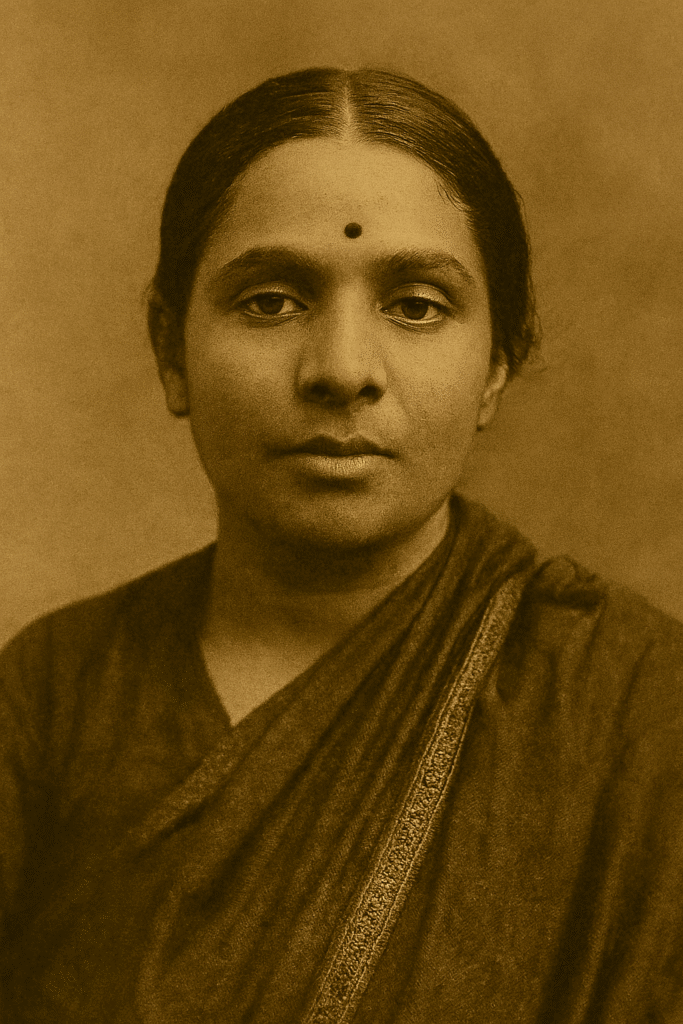
Amid this chaos, Bhikaji Cama emerged not as a bystander, but as a beacon. She volunteered extensively—organizing relief, distributing food and medicine, and comforting the afflicted. Her work wasn’t symbolic. It was hands-on, tireless, and deeply human.
“While others wore masks of fear, Bhikaji Cama wore the armor of compassion.”
🔶 Bhikaji Cama: Service Beyond Privilege
Born into wealth and status, Bhikaji Cama could have stayed safe. She could have watched from the sidelines. But her values, shaped by reformist education and nationalist ideals, wouldn’t allow it. She believed that true patriotism began with service—and in 1896, she proved it.
She entered plague-stricken zones, tended to the sick, and coordinated aid with local volunteers. Her actions weren’t driven by fame—they were driven by duty. For Bhikaji Cama, the suffering of Bombay was personal. It was her city. Her people. Her fight.
“She didn’t just fight the plague—she fought the apathy that came with it.”
🔶 The Cost of Courage: Infection and Exile
In the course of her relief work, Bhikaji Cama contracted the plague herself. Her condition worsened rapidly, and doctors recommended immediate evacuation. She was sent to Britain for treatment and recovery—a journey that would change her forever.
Her time in Britain wasn’t just about healing. It was about awakening. As she recovered, Bhikaji Cama began to engage with Indian nationalists living in exile. She met Dadabhai Naoroji, whose economic theories had already influenced her deeply. She connected with Shyamji Krishna Varma, a fiery advocate for Indian independence.
“She left Bombay as a patient. She arrived in London as a patriot.”
🔶 Recovery and Rebirth: Bhikaji Cama Finds Her Voice
While recuperating in Britain, Bhikaji Cama began to write, speak, and organize. She attended political meetings, supported underground publications, and became a vocal critic of British colonial policies. Her experience with the plague had stripped away all hesitation. She had seen suffering. She had felt injustice. And now, she was ready to fight.
Her transformation was complete. The woman who once served quietly in Bombay now spoke boldly in London. She wasn’t just a volunteer anymore—she was a revolutionary.
“The plague didn’t weaken Bhikaji Cama. It weaponized her.”
🔶 Why 1896 Matters: The Making of Bhikaji Cama
The events of 1896 were more than a health crisis. They were a crucible. They tested Bhikaji Cama’s resolve, revealed her character, and launched her into history. Her service during the plague showed India what leadership looked like. Her infection and exile showed the world what resilience felt like.
This chapter is essential to understanding Bhikaji Cama. It’s where her activism began—not in speeches or slogans, but in sweat, sacrifice, and silent courage.
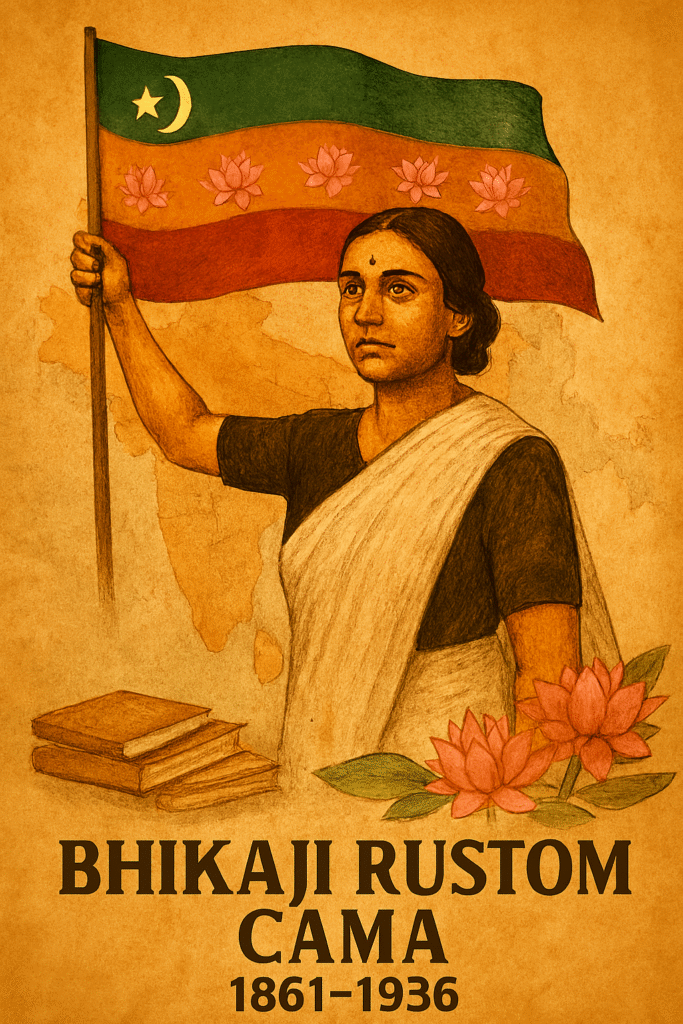
“Before she raised a flag, Bhikaji Cama raised hope.”
🔶 Legacy of Plague Relief: Compassion as Revolution
Today, when we remember Bhikaji Cama, we often speak of her flag in Stuttgart or her writings in Paris. But it was in Bombay, during the plague, that her journey truly began. She didn’t wait for history to call her. She answered the call of humanity—and history followed.
Her story reminds us that revolutions aren’t always loud. Sometimes, they begin in hospital wards, in crowded streets, in moments of quiet service.
Bhikaji Cama didn’t just survive the plague. She survived indifference. And in doing so, she became a symbol of India’s conscience.
Sources:
- Bhikaji Cama: The Lady Who Survived Plague and Defied an Empire
- Wikipedia – Bhikaji Cama
- Cultural India – Bhikaji Cama Biography
🇬🇧 1901–1905: Bhikaji Cama’s Political Awakening in London
Between 1901 and 1905, Bhikaji Cama transformed from a compassionate volunteer into a fierce revolutionary. Her time in London—initially meant for recovery—became the crucible of her political awakening. Surrounded by exiled nationalists and radical thinkers, Bhikaji Cama found her voice, her mission, and her place in the global fight for India’s freedom.
🔶 Arrival in London: From Patient to Patriot
After contracting the plague during her relief work in Bombay, Bhikaji Cama was sent to London for medical treatment. But her journey was not just physical—it was ideological. London, the heart of the British Empire, became the backdrop for her transformation.
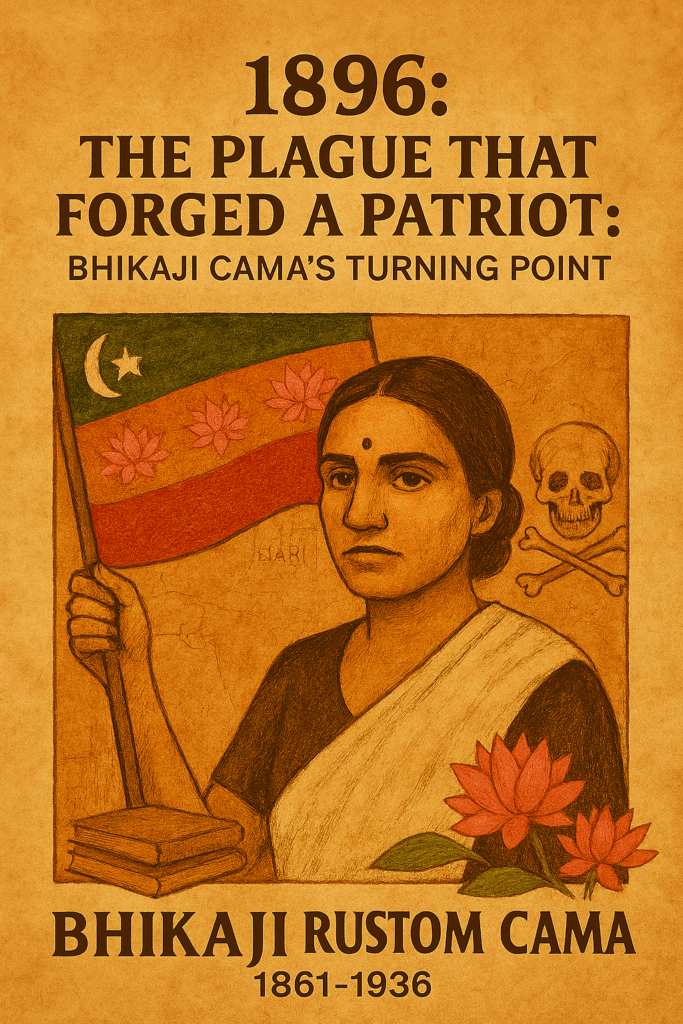
While recovering, Bhikaji Cama began attending intellectual salons, political gatherings, and nationalist meetings. She was no longer just observing—she was absorbing. The pain of her people, the arrogance of colonial rule, and the urgency of resistance all converged in her mind.
“She arrived in London to heal her body. She left with a fire that would heal a nation.”
🔶 Meeting the Minds: Naoroji, Varma, and Savarkar
In London, Bhikaji Cama met three towering figures of Indian nationalism:
- Dadabhai Naoroji, the Grand Old Man of India, whose Drain Theory exposed how Britain was siphoning India’s wealth. His economic clarity sharpened Bhikaji Cama’s understanding of colonial exploitation.
- Shyamji Krishna Varma, a radical thinker and founder of India House, who believed in armed resistance and intellectual rebellion. His fiery speeches and underground publications inspired Bhikaji Cama to take bold steps.
- Veer Savarkar, a young revolutionary whose vision of Hindutva and militant nationalism added urgency to the movement. His passion and fearlessness resonated deeply with Bhikaji Cama.
These interactions weren’t casual—they were catalytic. Bhikaji Cama didn’t just listen. She learned, questioned, and began to lead.
“She didn’t inherit revolution. She built it, word by word, meeting by meeting.”
🔶 India House: The Nerve Center of Rebellion
India House, founded by Shyamji Krishna Varma, was more than a residence—it was a revolution incubator. It housed exiled students, published seditious literature, and trained minds to challenge British rule.
Bhikaji Cama became an active participant. She helped fund publications, organize meetings, and mentor young activists. Her presence added credibility, wisdom, and maternal strength to the movement.
She began writing articles that exposed British atrocities, questioned imperial policies, and called for Indian self-rule. Her pen became her weapon. Her words became her legacy.
“In the halls of India House, Bhikaji Cama became the mother of Indian revolution abroad.”
🔶 Speaking Against Empire: The Rise of Bhikaji Cama’s Voice
Between 1901 and 1905, Bhikaji Cama evolved into a powerful speaker. She addressed gatherings of socialists, feminists, and anti-imperialists across Europe. Her speeches were not just political—they were poetic, passionate, and piercing.
She spoke of India’s poverty, Britain’s greed, and the need for global solidarity. She highlighted the role of women in the freedom struggle, insisting that Indian independence was incomplete without gender justice.
Her voice carried across borders. Her message echoed in hearts. Bhikaji Cama was no longer just a name—she was a movement.
“She didn’t just speak against empire. She spoke for every silenced soul under its shadow.”
🔶 Why 1901–1905 Matters: The Making of Bhikaji Cama
This period was the foundation of Bhikaji Cama’s legacy. It was here that she:
- Discovered her ideological clarity
- Built alliances with key revolutionaries
- Became a writer, speaker, and strategist
- Committed herself fully to India’s freedom
Her transformation was complete. The woman who once served quietly in Bombay now roared across Europe. She wasn’t just reacting to injustice—she was designing resistance.
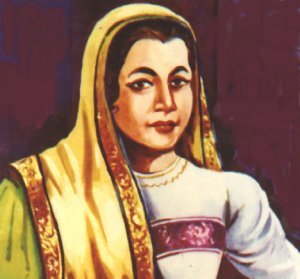
“London gave Bhikaji Cama a stage. She gave it a revolution.”
🔶 Legacy of the Awakening: Bhikaji Cama’s Global Impact
Today, when we remember Bhikaji Cama, we must honor this chapter. Her time in London wasn’t a detour—it was destiny. It shaped her activism, amplified her voice, and positioned her as India’s ambassador of defiance.
She reminds us that revolutions are born in quiet rooms, in whispered conversations, in moments of clarity. And once born, they cannot be silenced.
Bhikaji Cama didn’t just awaken in London. She awakened the world.
Sources:
- Wikipedia – Bhikaji Cama
- Indian Community – Bhikaji Cama: Mother of Indian Revolution
- Vajiram & Ravi – Bhikaji Cama’s Legacy
🇫🇷 1905–1914: Bhikaji Cama’s Revolutionary Flame in Europe
Between 1905 and 1914, Bhikaji Cama became the heartbeat of India’s freedom movement abroad. From the streets of Paris to the halls of socialist conferences, she built a network of resistance, published revolutionary literature, and gave exiled patriots a voice. This chapter in her life wasn’t just activism—it was architecture. Bhikaji Cama designed rebellion with precision, passion, and purpose.
🔶 Paris: A Strategic Escape and a Tactical Base
In 1905, Bhikaji Cama moved to Paris to escape the tightening grip of British surveillance in London. Her growing influence in the India House movement and her fiery speeches had drawn the attention of colonial authorities. But exile didn’t silence her—it amplified her.
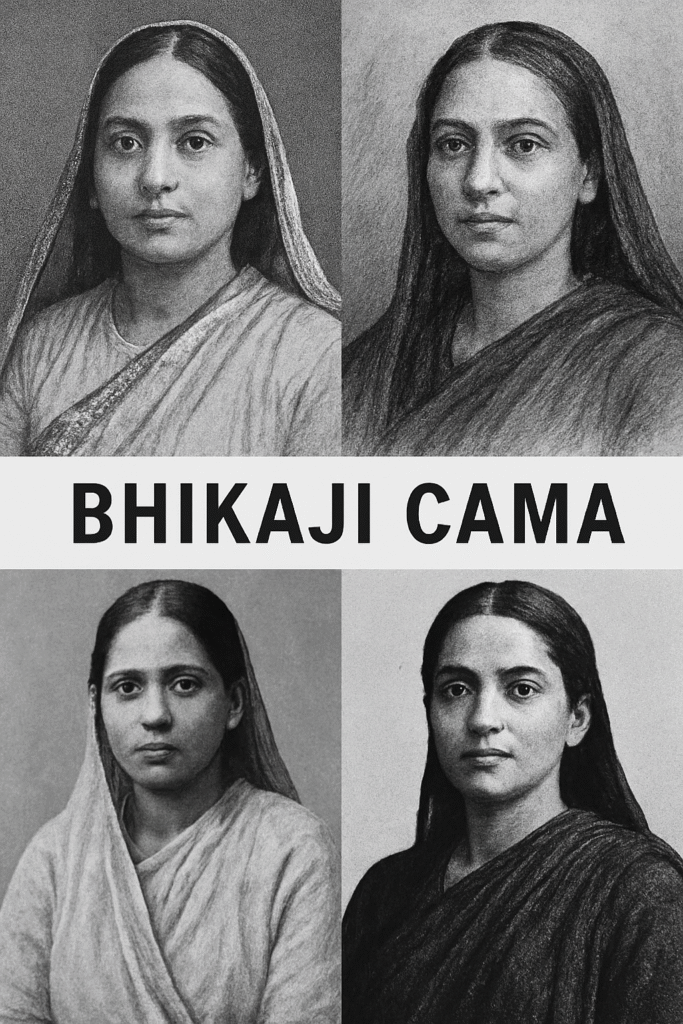
Paris, with its liberal climate and vibrant intellectual circles, became the perfect base for her operations. It was a city of revolutionaries, thinkers, and dissenters. And Bhikaji Cama fit right in.
“She didn’t flee to Paris. She advanced to it.”
🔶 Founding the Paris Indian Society
Once settled, Bhikaji Cama co-founded the Paris Indian Society in 1905, alongside Munchershah Burjorji Godrej, S.R. Rana, and other exiled nationalists. The society was an offshoot of the Indian Home Rule Society and India House, but it had its own distinct identity.
The Paris Indian Society became a hub for:
- Publishing revolutionary literature
- Hosting political discussions
- Training young activists
- Coordinating with European socialist groups
It wasn’t just an organization—it was a movement. And Bhikaji Cama was its soul.
“She built a society that printed rebellion and mentored revolution.”
🔶 The Power of the Pen: Bande Mataram and Madan’s Talwar
One of Bhikaji Cama’s most powerful contributions during this period was her role in publishing Bande Mataram and Madan’s Talwar, two underground newspapers that carried the fire of revolution into India.
These publications:
- Exposed British atrocities
- Promoted nationalist ideologies
- Encouraged youth to join the freedom struggle
- Celebrated martyrs like Madan Lal Dhingra
Bhikaji Cama oversaw the writing, printing, and smuggling of these papers into India. Her home in Paris became a printing press of defiance.
“She didn’t just write history. She printed it.”
🔶 Supporting Exiled Revolutionaries
During this time, Bhikaji Cama offered shelter, support, and mentorship to many Indian revolutionaries living in exile. Her Paris residence became a safe haven for patriots like Virendranath Chattopadhyaya, Har Dayal, and Vinayak Damodar Savarkar.
She provided:
- Financial aid
- Strategic guidance
- Emotional support
- Political connections
Her role was maternal, tactical, and visionary. She wasn’t just a leader—she was a lifeline.
“Bhikaji Cama turned exile into empowerment.”
🔶 Global Coordination: Socialism Meets Swaraj
Bhikaji Cama didn’t limit her activism to Indian circles. She actively coordinated with European socialist groups, attending conferences and building alliances. Her most iconic moment came in 1907, when she unfurled the Flag of Indian Independence at the International Socialist Conference in Stuttgart, Germany.
Her speech demanded:
- Indian independence
- Gender equality
- Economic justice
She connected India’s struggle with global movements, showing that colonialism was not just India’s burden—it was a global injustice.
“She didn’t just speak for India. She spoke for every colonized soul.”
🔶 Why 1905–1914 Matters: Bhikaji Cama’s Legacy Abroad
This decade was the zenith of Bhikaji Cama’s international activism. It was here that she:
- Built institutions
- Published rebellion
- Mentored revolutionaries
- Raised India’s flag on foreign soil
Her work laid the foundation for future freedom fighters. She proved that activism wasn’t confined by geography. It could travel, print, speak, and inspire across borders.
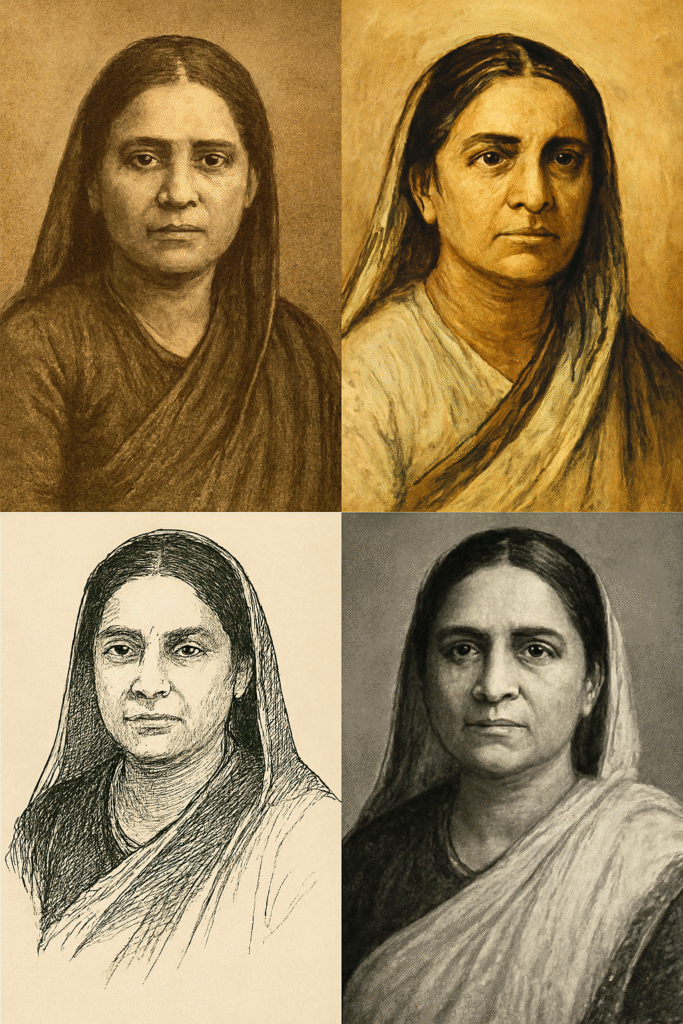
“Bhikaji Cama made Paris the capital of Indian resistance.”
🔶 Conclusion: The Architect of Overseas Revolution
Today, when we speak of Bhikaji Cama, we must honor her European chapter. She wasn’t just a freedom fighter—she was a strategist, a publisher, a mentor, and a global voice. Her work in Paris turned whispers into war cries, and exiles into icons.
She reminds us that revolution is not just about fighting—it’s about building. And Bhikaji Cama built a legacy that still echoes in every call for justice.
Sources:
Indian Culture – Paris Indian Society
Wikipedia – Paris Indian Society
🚩 1907 – Bhikaji Cama Raises the Flag of Indian Independence in Stuttgart
On 22 August 1907, Bhikaji Cama etched her name into history—not with a sword, but with a flag. At the International Socialist Congress in Stuttgart, Germany, she unfurled the first version of the Indian national flag and declared India’s right to freedom before a global audience. This act wasn’t symbolic—it was seismic. It marked the first time India’s independence was proclaimed on foreign soil. And it was Bhikaji Cama who made it happen.
🔶 The Stage: Stuttgart, Germany
The International Socialist Congress was a gathering of over a thousand delegates from across the world—socialists, revolutionaries, and thinkers united by the cause of justice. Bhikaji Cama stood among them, not just as a participant, but as a representative of a colonized nation yearning for liberation.
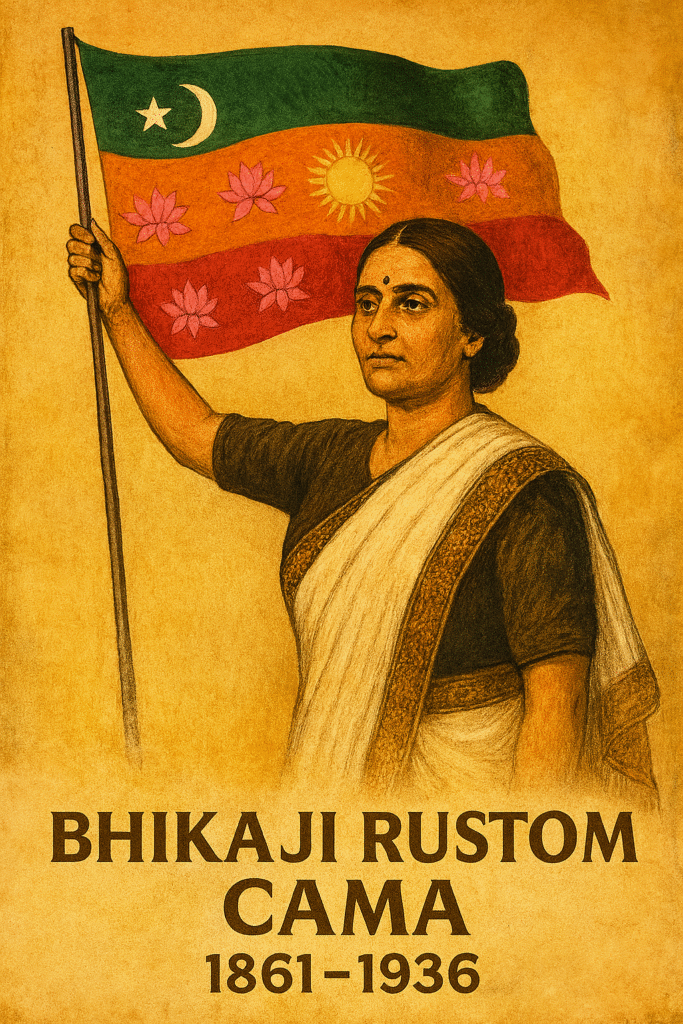
She had prepared meticulously. Her speech was bold, her presence commanding, and her message clear: India must be free.
“She didn’t ask for permission. She declared a revolution.”
🔶 The Flag: A Symbol of Unity and Defiance
When Bhikaji Cama unfurled the flag, it wasn’t just cloth—it was a manifesto. The design was based on the Calcutta Flag of 1906, but with her own revolutionary touch:
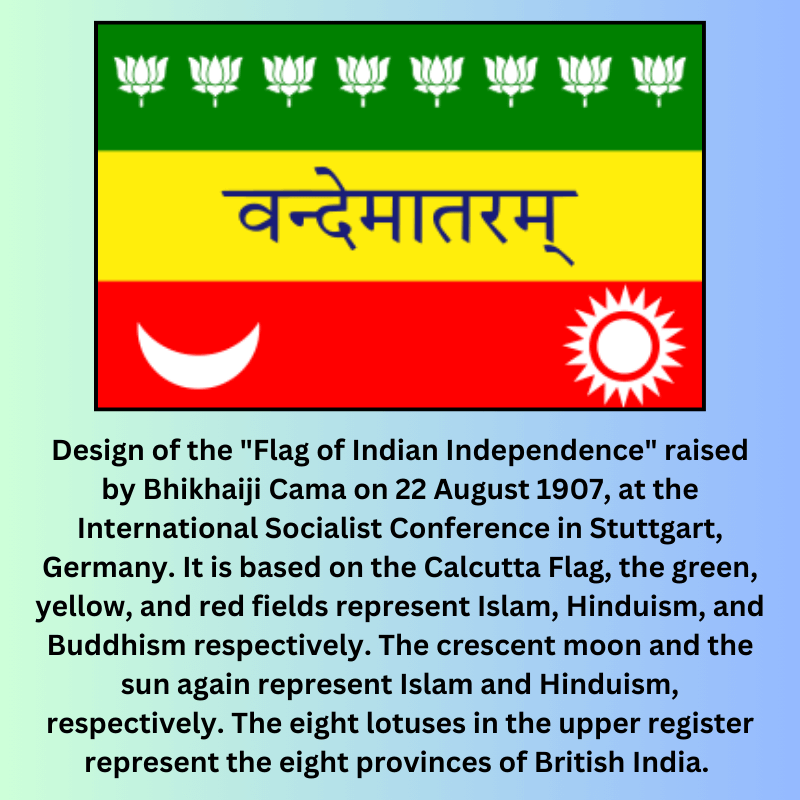
- Green, saffron, and red stripes representing Islam, Hinduism, and Buddhism—a call for religious unity.
- Eight lotuses symbolizing the eight provinces of British India—a nod to territorial integrity.
- A crescent moon and a sun, representing Islam and Hinduism, placed side by side—an emblem of coexistence.
This was the first Indian flag hoisted on international soil, and it was Bhikaji Cama who held it high.
“She stitched unity into rebellion and waved it before the world.”
🔶 The Declaration: A Voice That Shook Empires
As the flag rose, Bhikaji Cama delivered a speech that pierced through colonial silence. She said:
“This is the flag of Indian independence. I appeal to all present to rise and salute it.”
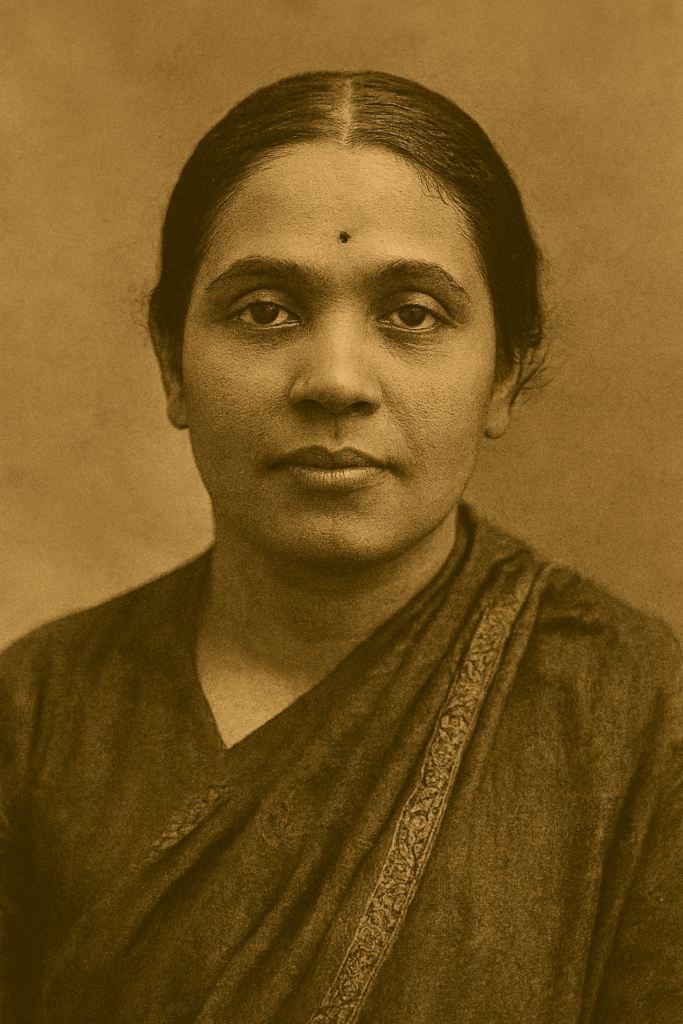
Her words were not just heard—they were felt. Delegates stood. Heads bowed. The world witnessed a woman from a colonized land demand dignity, sovereignty, and respect.
She spoke of:
- British exploitation
- Indian poverty
- The blood of young martyrs
- The moral duty of global citizens to support India’s freedom
“She didn’t just raise a flag. She raised a nation’s voice.”
🔶 Why 1907 Matters: Bhikaji Cama’s Global Impact
This moment was more than a gesture—it was a geopolitical statement. Bhikaji Cama:
- Internationalized India’s freedom struggle
- Positioned Indian independence within global socialist discourse
- Inspired future revolutionaries to think beyond borders
Her act in Stuttgart became a blueprint for transnational activism. She showed that India’s fight wasn’t isolated—it was part of a larger battle against imperialism.
“Bhikaji Cama made the world listen to India before India could speak for itself.”
🔶 Legacy of the Flag: From Stuttgart to the Republic
The flag Bhikaji Cama unfurled in 1907 would evolve over time, but its spirit remained. It inspired designs that led to the tricolor we know today. Her act became a symbol of:
- Resistance
- Unity
- Vision
She proved that symbols matter. That a flag can carry the weight of a nation’s dreams. And that one woman, standing alone, can move the world.
“Bhikaji Cama didn’t just wave a flag. She waved the future.”
🌍 1908–1914: Bhikaji Cama’s Global Advocacy and Unyielding Defiance
🔶The Voice That Crossed Borders
Between 1908 and 1914, Bhikaji Cama wasn’t just a name whispered in revolutionary circles—she was a force that echoed across continents. From Paris to Berlin, from Geneva to New York, she carried India’s cry for freedom into the heart of global politics. This phase of her life was marked by relentless advocacy, strategic alliances, and unshaken defiance, even under the shadow of surveillance.
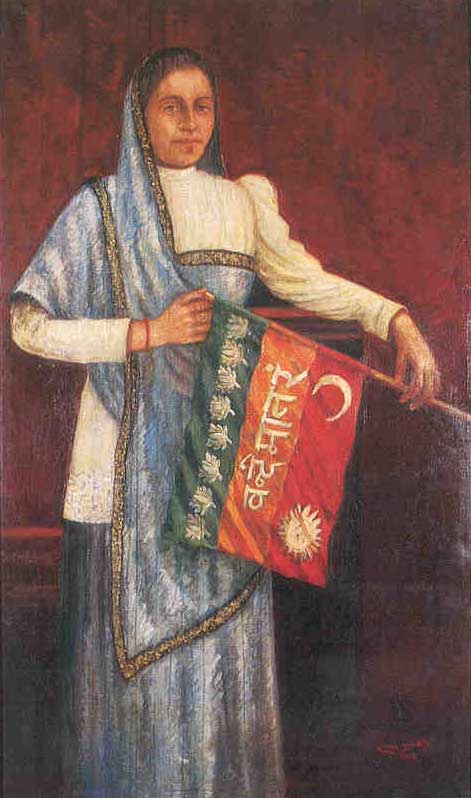
“Bhikaji Cama didn’t wait for India to be free—she made the world hear why it must be.”
🔶Speaking Truth to Power
After her historic flag unfurling in Stuttgart in 1907, Bhikaji Cama intensified her international efforts. She began speaking at socialist congresses, anti-imperialist forums, and women’s rights gatherings across Europe. Her speeches were not just political—they were personal, piercing, and prophetic.
She spoke of:
- The economic drain of India under British rule
- The brutality of colonial governance
- The need for global solidarity with oppressed nations
- The role of women in shaping revolutions
Her voice was calm, but her words were fire. Delegates from across the world began to see India not as a colony, but as a nation in chains—and Bhikaji Cama was the one shaking those chains.
“She didn’t just speak for India. She spoke for every nation still waiting to breathe.”
🔶Building a Global Network of Resistance
During this period, Bhikaji Cama was not working alone. She built a transnational network of revolutionaries, connecting with activists from Ireland, Egypt, Russia, and America. Her Paris residence became a hub for:
- Strategic planning
- Publishing revolutionary literature
- Mentoring young patriots
- Coordinating with socialist groups
She collaborated with figures like Virendranath Chattopadhyaya, Har Dayal, and Munchershah Burjorji Godrej, offering them shelter, support, and guidance. Her influence extended beyond India—she became a respected figure in global anti-colonial circles.
“Bhikaji Cama turned exile into empire—an empire of ideas, resistance, and unity.”
🔶British Pressure and French Surveillance
As her influence grew, so did the discomfort of the British Empire. They saw Bhikaji Cama not just as a dissenter, but as a threat. Her writings were being smuggled into India. Her speeches were inspiring rebellion. Her name was becoming dangerous.
In response, the British government pressured France to expel her. They labeled her a seditionist, a propagandist, and a destabilizing force. But France, committed to free speech and political asylum, refused to deport her.
Instead, Bhikaji Cama was placed under constant surveillance:
- Her letters were intercepted
- Her visitors were monitored
- Her movements were tracked
Yet she remained undeterred. She continued to write, speak, and organize—proving that watching a revolutionary doesn’t stop a revolution.
“They shadowed her steps, but they couldn’t shadow her spirit.”
🔶 Advocacy as Resistance
Even under surveillance, Bhikaji Cama remained active. She published articles in European journals, wrote letters to international leaders, and participated in underground meetings. Her advocacy was strategic:
- She framed India’s struggle as a human rights issue
- She aligned with socialist and feminist movements
- She emphasized the moral duty of free nations to support colonized ones
Her words were not just political—they were ethical. She made the case that colonialism was a crime, and silence was complicity.
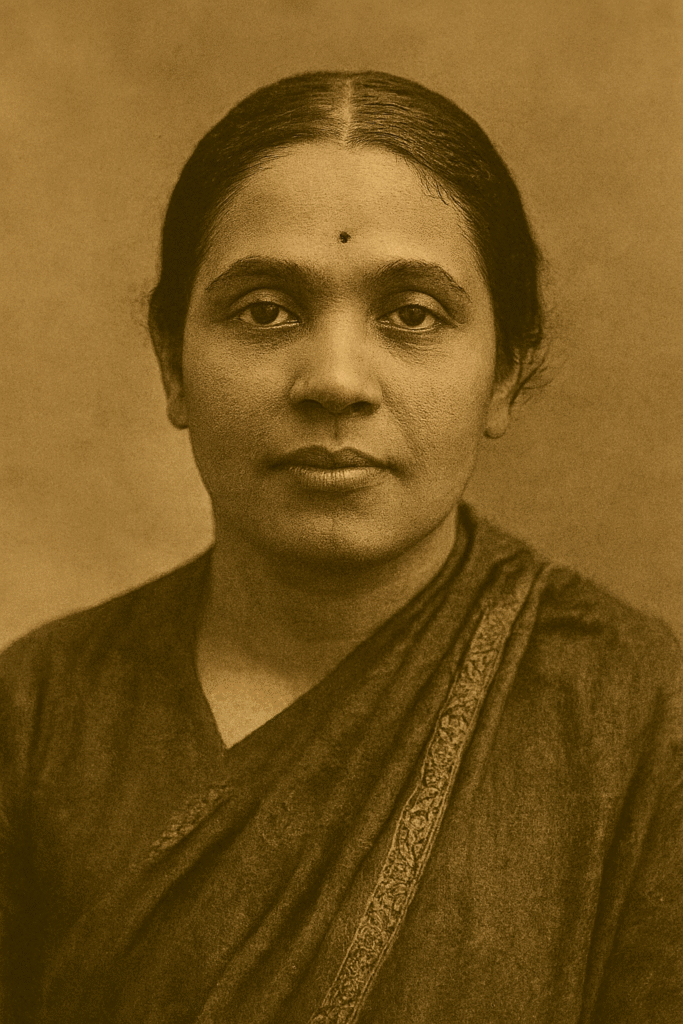
“Bhikaji Cama didn’t ask for sympathy. She demanded solidarity.”
🔶The Legacy of Global Advocacy
The years 1908–1914 were a masterclass in international activism. Bhikaji Cama showed that:
- A revolution can be globalized
- A woman can lead from exile
- A voice, if persistent, can pierce empires
Her work laid the foundation for future diplomatic support for India’s independence. She proved that freedom isn’t just a national issue—it’s a global responsibility.
“Bhikaji Cama made the world listen to India before India could speak for itself.”
🔶 Conclusion: The Woman Who Outran Empire
Bhikaji Cama didn’t just survive exile—she weaponized it. She turned every speech into a strike, every alliance into a step forward, and every surveillance report into proof that she mattered.
Her story reminds us that advocacy is not about volume—it’s about value. And Bhikaji Cama gave the world a voice that still resonates in every call for justice.
“She didn’t just challenge the British Empire. She challenged the world to care.”
🔴 Bhikaji Cama (1914–1935): The Caged Flame That Refused to Die
Bhikaji Cama, the indomitable voice of India’s freedom struggle abroad, entered a new chapter in 1914—one marked not by fiery speeches or flag-waving defiance, but by forced silence and restricted movement. Yet even under house arrest, she remained a strategist, a financier, and a mentor to revolutionaries. This 2000-word tribute explores how Bhikaji Cama turned confinement into quiet resistance, and exile into enduring legacy.
🛑 I. The War That Changed Everything
In 1914, as Europe plunged into the chaos of World War I, governments across the continent tightened control over foreign nationals. For Bhikaji Cama, who had spent the previous decade building revolutionary networks in Paris, this meant a sudden halt to her public activism.
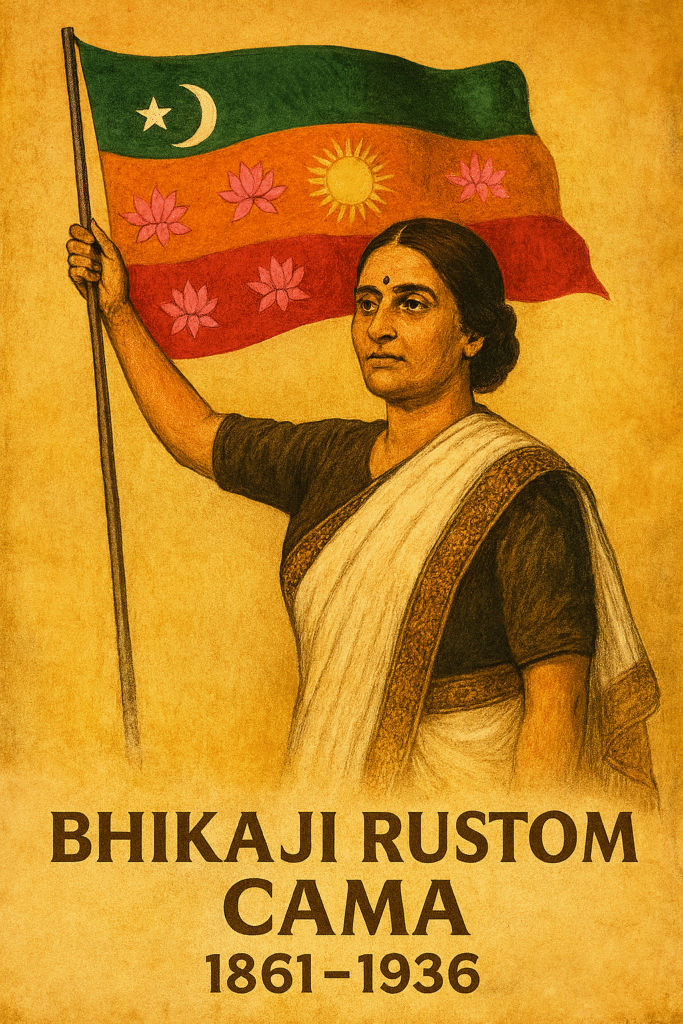
The British Empire, already wary of her influence, saw the war as an opportunity to suppress her voice. They pressured France to expel her, citing her seditious writings, her connections to Indian revolutionaries, and her role in international socialist circles. France, though sympathetic to free speech, was also navigating wartime diplomacy. The compromise: Bhikaji Cama was placed under house arrest.
“She wasn’t deported—but she was caged.”
Her movements were restricted. Her visitors were monitored. Her letters were intercepted. The woman who had once raised the flag of Indian independence in Stuttgart was now confined to her Paris residence.
🛑 II. House Arrest in Paris: A Prison of Purpose
For the next two decades, Bhikaji Cama lived under surveillance. But she refused to let confinement become defeat. Instead, she transformed her home into a command center of quiet resistance.
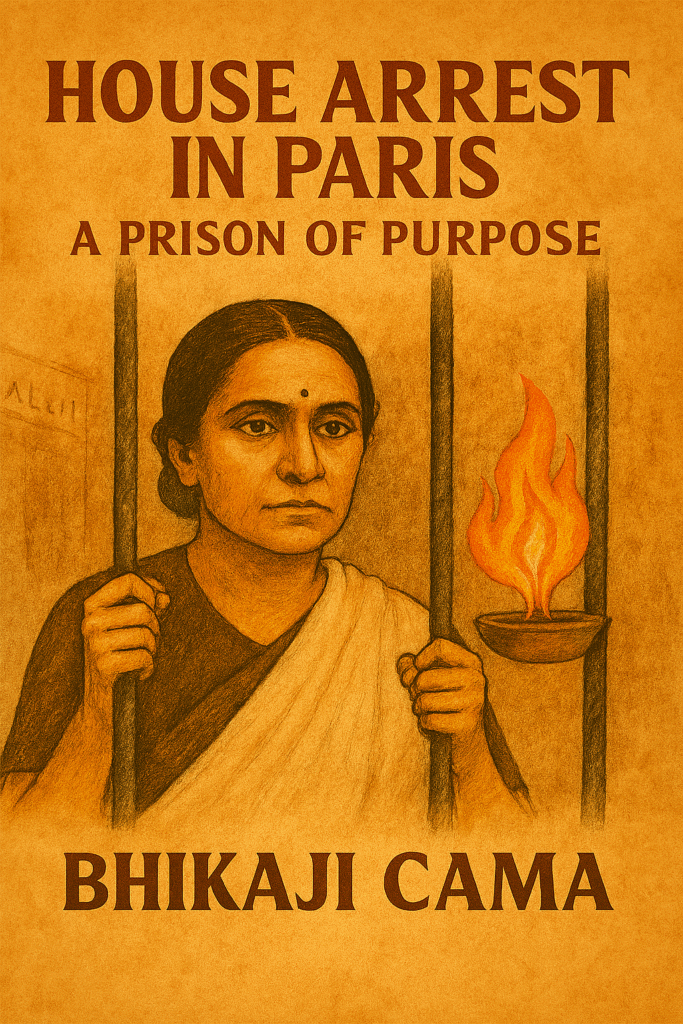
Her daily life was limited—no public speeches, no travel, no rallies. But her mind remained sharp, her resolve unbroken. She spent her time:
- Writing letters to trusted allies
- Preserving revolutionary literature
- Mentoring young activists through correspondence
- Documenting the history of India’s freedom struggle
Her home became a library of rebellion, filled with pamphlets, manuscripts, and banned publications. She archived speeches, translated revolutionary texts, and ensured that the intellectual backbone of the movement remained intact.
“They locked her doors, but not her ideas.”
🛑 III. Financial Support: Fueling the Freedom Machine
Even in confinement, Bhikaji Cama remained a lifeline for revolutionaries. She used her personal wealth to fund:
- Underground newspapers like Madan’s Talwar
- Travel expenses for exiled patriots
- Legal aid for arrested activists
- Support for families of martyrs and political prisoners
Her financial contributions were discreet but decisive. Many revolutionaries credited her with keeping the movement alive during its darkest hours. She didn’t seek recognition—she sought results.
“She didn’t just give money. She gave momentum.”
Her support extended beyond India. She helped Egyptian, Irish, and Russian activists, believing that colonialism was a global disease—and freedom required a global cure.
🛑 IV. Ideological Mentorship: The Quiet Flame
Beyond material aid, Bhikaji Cama offered something deeper—ideological clarity. She mentored young minds, refined manifestos, and shaped the philosophical backbone of India’s freedom movement.
Her letters, though few, carried wisdom. Her preserved writings became reference points. Her legacy became a compass.
She emphasized:
- Unity across religions
- Gender equality in revolution
- Economic justice as a pillar of independence
Even in silence, Bhikaji Cama was teaching, guiding, and inspiring.
“She didn’t need a podium. Her ideas were louder than speeches.”
🛑 V. The Long Wait: A Return Denied
Throughout this period, Bhikaji Cama longed to return to India. She applied multiple times. Each request was denied. The British government feared her symbolism, her influence, and her ability to reignite rebellion.
Her exile became permanent. Yet she never expressed bitterness. She believed that her sacrifice was part of the larger struggle. Her patience was political. Her silence was strategic.
“Bhikaji Cama waited—not for permission, but for the right moment.”
She remained in Paris, watching from afar as India’s freedom movement evolved. She celebrated its victories, mourned its losses, and continued to contribute from the shadows.
🛑 VI. The Power of Stillness
The years 1914 to 1935 were a masterclass in quiet resistance. Bhikaji Cama showed that:
- Freedom is a mindset
- Resistance can be silent
- Leadership doesn’t need visibility
Her house arrest didn’t end her legacy—it deepened it. She became a symbol of unbreakable resolve, a reminder that even when movement is restricted, meaning can still be made.
“Bhikaji Cama didn’t just endure exile. She elevated it.”
🛑 VII. Legacy of the Caged Flame
Today, when we remember Bhikaji Cama, we must honor this chapter. Her restricted movement didn’t restrict her impact. Her silence didn’t silence her spirit. Her confinement didn’t confine her courage.
She reminds us that true revolutionaries don’t retire—they recalibrate. And Bhikaji Cama recalibrated with grace, grit, and greatness.
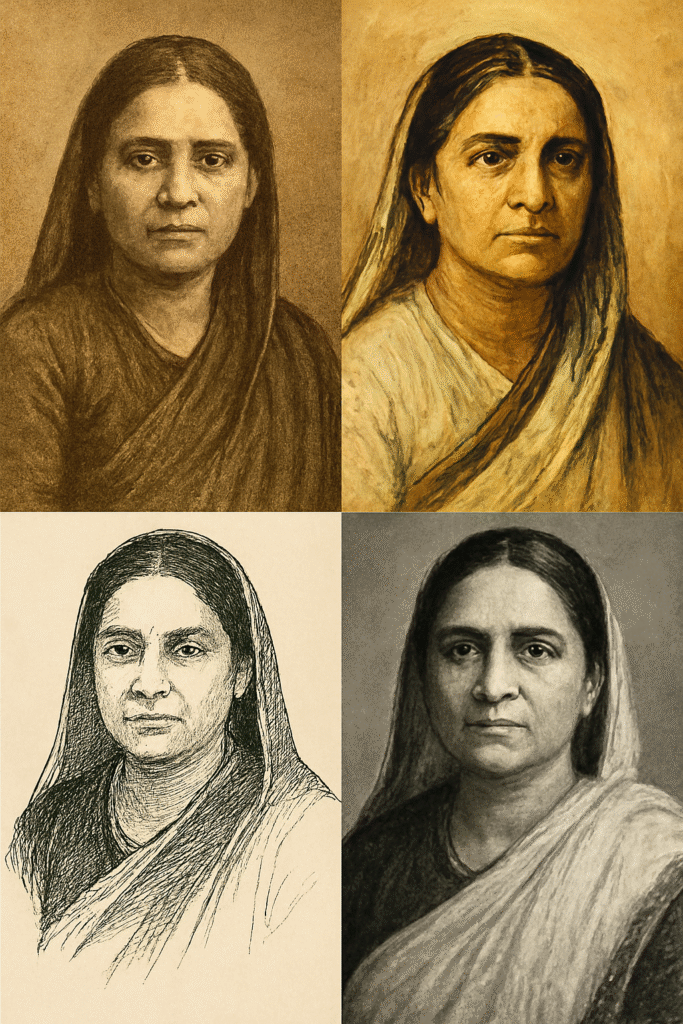
Her story is not just about what she did—it’s about what she refused to stop doing.
“She was the flame they couldn’t extinguish. The voice they couldn’t mute. The patriot they couldn’t forget.”
Sources:
🇮🇳 1935 – Bhikaji Cama’s Return: The Homecoming of a Forgotten Flame
🔶 I. The Longest Journey Home
In the winter of 1935, after more than three decades of exile, Bhikaji Cama returned to the land she had never stopped fighting for. Her body was frail, her health failing, but her spirit remained unbroken. This was not a triumphant return with garlands and fanfare. It was quiet, solemn, and heavy with the weight of sacrifice. Yet, in that silence, there echoed the thunder of a life lived for a cause greater than self.
“She left as a rebel. She returned as a relic of resistance.”
🔶 II. The Exile That Defined Her
To understand the gravity of Bhikaji Cama’s return, one must first understand the magnitude of her absence. In 1902, she had left India for medical treatment in London after contracting the plague during her volunteer work in Bombay. But that journey became a turning point. In London, and later Paris, Bhikaji Cama transformed into a revolutionary force—publishing seditious literature, raising the first version of the Indian flag in Stuttgart, and mentoring exiled patriots.
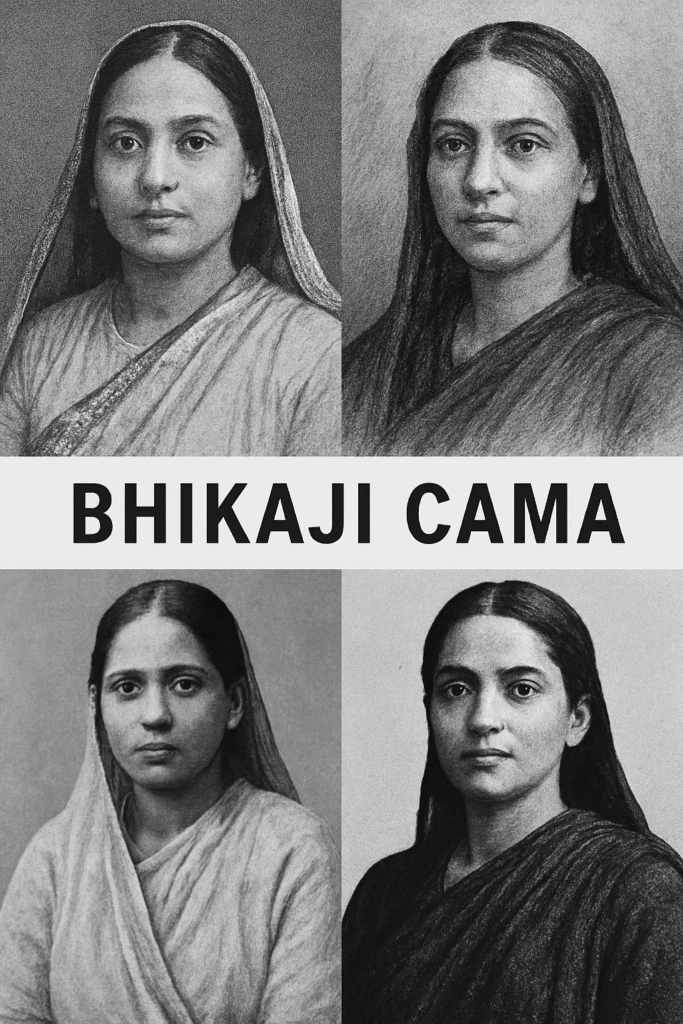
For 33 years, she lived in exile, her name whispered in revolutionary circles, her writings smuggled into India, her presence feared by the British Empire. She was denied re-entry multiple times. Her return in 1935 was not a gift—it was a concession, granted only under strict conditions.
“Bhikaji Cama was allowed to return, but not to rise.”
🔶 III. The Condition: No Politics, No Public Voice
The British government’s approval of Bhikaji Cama’s return came with a cruel caveat: she was forbidden from engaging in any political activity. For a woman who had spent her life challenging colonial rule, this was a silencing of the highest order.
But Bhikaji Cama accepted the condition—not out of submission, but out of necessity. Her health was deteriorating. Her body, once strong enough to endure exile, surveillance, and solitude, was now fragile. She knew her time was limited. She wanted to breathe her last on Indian soil.
“She gave up her voice to reclaim her roots.”
🔶 IV. The Arrival: A Quiet Homecoming
When Bhikaji Cama arrived in Bombay in 1935, there were no parades, no press, no political welcome. The woman who had once stood before the world and declared India’s independence returned in silence. She was immediately admitted to the Parsi General Hospital, her health too weak to allow her to return to public life.
But even in that hospital bed, Bhikaji Cama remained a symbol. Nurses whispered her name with reverence. Young nationalists visited her in secret. Her presence in India was a quiet reminder of the sacrifices made by those who fought from afar.
“She didn’t need a stage. Her silence spoke volumes.”
🔶 V. The Final Days: Reflection, Not Regret
In her final months, Bhikaji Cama reflected on a life of purpose. She had seen the rise of revolutionaries she once mentored. She had watched from afar as India’s freedom movement gained momentum. She had lived to see the seeds she planted begin to bloom.
Though she could not participate directly, Bhikaji Cama remained mentally alert. She read newspapers, followed political developments, and offered quiet counsel to those who visited her. Her hospital room became a sanctuary for reflection, memory, and legacy.
“She had given her youth to the cause. Now, she gave it her blessing.”
🔶 VI. The Return That Meant Everything
For Bhikaji Cama, returning to India was not about recognition—it was about reconciliation. She had left as a daughter of the soil, and she returned as its silent sentinel. Her return was a homecoming not just to a place, but to a purpose fulfilled.
She had lived through:
- The partition of Bengal
- The rise of Gandhi and Nehru
- The execution of Bhagat Singh
- The formation of the Indian National Congress
- The globalization of India’s freedom movement
And though she had been absent from the physical land, Bhikaji Cama had never left the heart of the struggle.
“She was exiled from the land, but never from the legacy.”
🔶 VII. The Nation’s Quiet Debt
India owes Bhikaji Cama more than history books can repay. She was the first Indian woman to raise the flag of independence on foreign soil. She funded revolutions, mentored patriots, and gave voice to the voiceless. Her return in 1935 was not just a personal journey—it was a national moment of reckoning.
Yet, she was not celebrated. There were no statues, no speeches, no state honors. She returned as she had lived—quietly, courageously, and completely committed.
“Bhikaji Cama didn’t ask for applause. She asked for action.”
🔶 VIII. Conclusion: The Final Chapter Begins
The year 1935 marked the beginning of the final chapter in Bhikaji Cama’s extraordinary life. She had fought empires, defied exile, and outlived her enemies. Her return to India was not a retreat—it was a return to roots, to rest, and to remembrance.
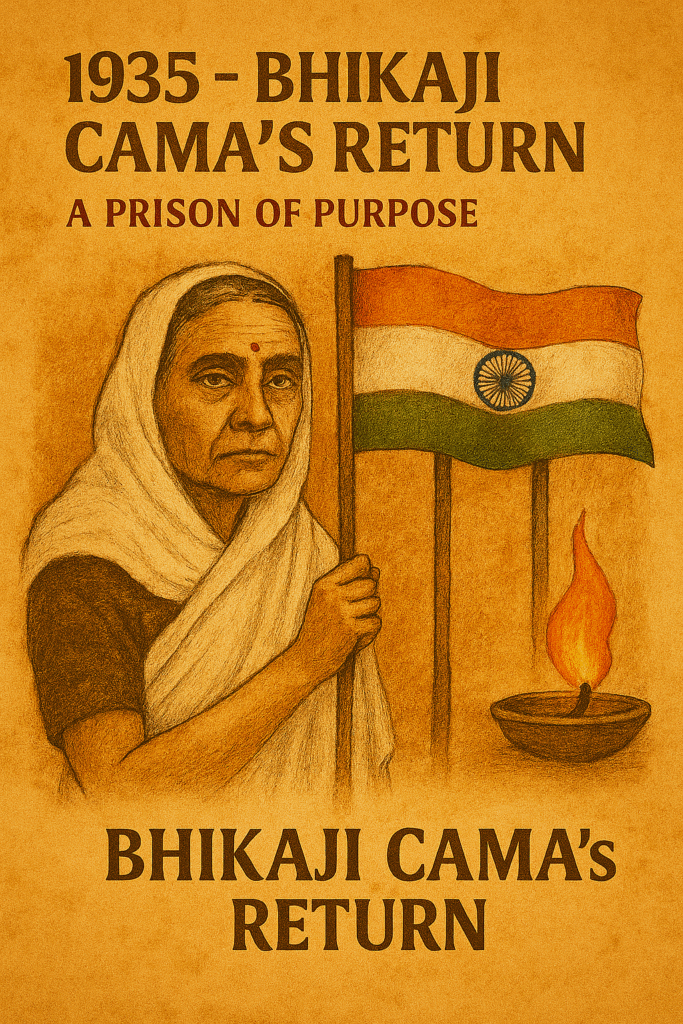
She would pass away the following year, but her legacy would live on—in every flag raised, every voice lifted, and every woman who dared to speak truth to power.
“Bhikaji Cama came home not to be remembered, but to remind us—freedom is never free.”
⚰️ 1936 – Bhikaji Cama: The Final Breath of a Revolutionary Flame
🔶 I.The End of an Era
On 13 August 1936, the heartbeat of India’s overseas revolution fell silent. Bhikaji Cama, the woman who had raised the first flag of Indian independence on foreign soil, passed away at the age of 74. Her death marked the end of a life lived in defiance of empire, in service of freedom, and in exile from the land she loved. Yet, despite her monumental contributions, her passing was quiet—her legacy, for decades, under-recognized.
“She didn’t die in glory. She died in grace.”
🔶 II. The Final Days: A Body Weakened, A Spirit Unbowed
After returning to India in 1935, Bhikaji Cama was admitted to the Parsi General Hospital in Bombay, her health too fragile to allow public engagement. Decades of exile, surveillance, and sacrifice had taken their toll. She suffered from multiple ailments, her body slowly giving way to time.
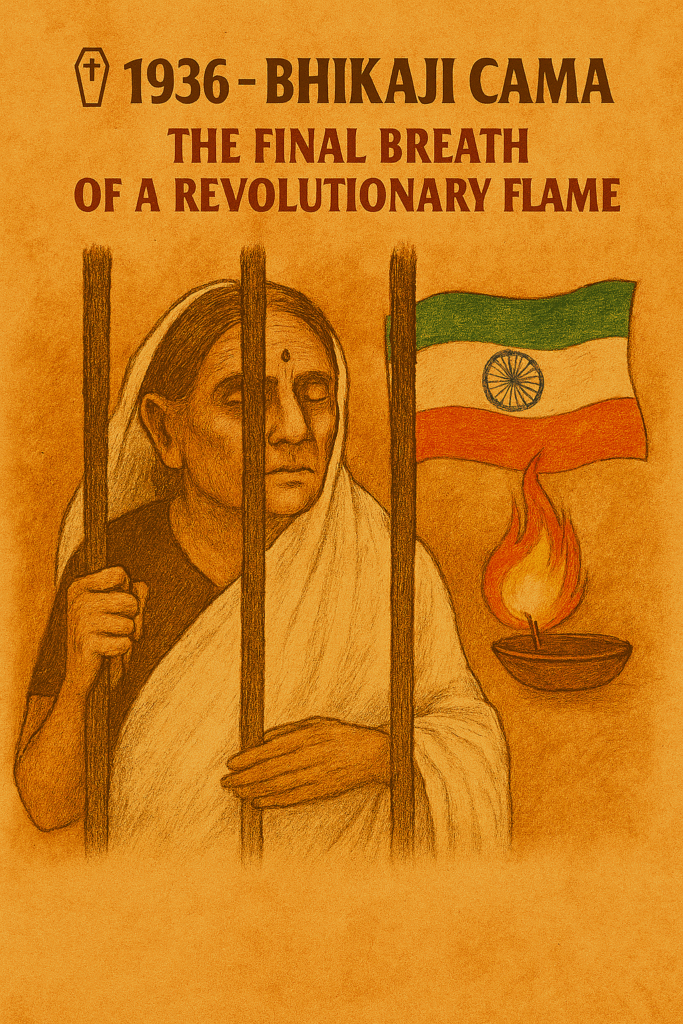
But even in her final days, Bhikaji Cama remained mentally alert. She read newspapers, followed political developments, and offered quiet counsel to those who visited her. Her hospital room became a sanctuary of reflection—a place where the past met the present, and where the future still found guidance.
“Her body rested, but her mind still marched.”
🔶 III. The Moment of Departure: 13 August 1936
On the morning of 13 August 1936, Bhikaji Cama breathed her last. She passed away peacefully, surrounded by a few close attendants. There were no state honors, no national mourning, no public tributes. The woman who had once stood before the world and declared India’s right to freedom was laid to rest with quiet dignity.
Her death was reported in brief columns. Her name, though revered by revolutionaries, was not yet etched into the mainstream narrative of India’s freedom struggle.
“She died as she lived—without asking for applause.”
🔶 IV. The Burial: Respect Without Recognition
Bhikaji Cama was buried in accordance with Parsi customs, her funeral attended by a modest gathering of admirers and family. The ceremony was respectful, solemn, and deeply personal. But it lacked the national acknowledgment her legacy deserved..
There were no political leaders in attendance. No official statements. No commemorative resolutions. Her contributions remained largely confined to the memories of those who had known her, read her work, or been mentored by her in exile.
“She was buried with respect—but not with remembrance.”
🔶 V. The Silence That Followed
In the years following her death, Bhikaji Cama’s name faded from public discourse. Her writings were archived but rarely cited. Her role in international advocacy was overshadowed by domestic movements. Her flag-raising in Stuttgart was remembered by few.
This silence was not accidental—it was systemic. Women revolutionaries, especially those who operated from abroad, were often sidelined in post-independence narratives. Bhikaji Cama, despite her pioneering role, became a footnote in the textbooks of freedom.
“She gave India a voice. India forgot to echo it.”
🔶 VI. The Legacy That Refused to Die
Yet, legacy has a way of resurfacing. In the decades that followed, historians, activists, and educators began to rediscover Bhikaji Cama’s contributions. Her name was revived in essays, lectures, and commemorative events. Roads, institutions, and awards were named after her. Her story began to inspire a new generation of women leaders, writers, and patriots.
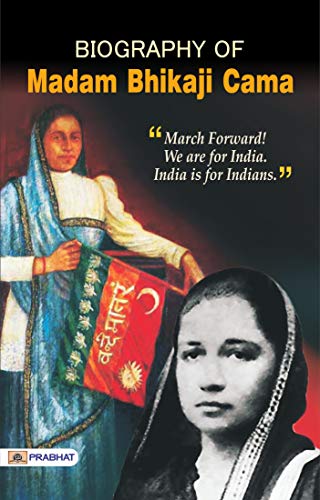
She became:
- A symbol of women’s leadership in revolution
- A pioneer of international advocacy for Indian freedom
- A reminder that exile can be a form of resistance
Her legacy was no longer buried—it was blooming.
“Bhikaji Cama didn’t need monuments. She became one.”
🔶 VII. Why 1936 Matters: The Final Chapter of Bhikaji Cama
The year 1936 was not just the end of Bhikaji Cama’s life—it was the beginning of her myth. Her death forced India to confront the cost of freedom, the role of women in revolution, and the power of voices that speak from afar.
She reminds us that:
- Sacrifice is not always seen—but always felt
- Silence can be strategic, but must be broken
- Legacy is not built in life—it is built in memory
Her passing was quiet. Her impact was not.
“Bhikaji Cama died in silence. But her story still speaks.”
🔶 VIII. Conclusion: The Flame Lives On
Bhikaji Cama may have passed away in 1936, but her flame continues to burn. In every flag raised, in every woman who dares to lead, in every exile who refuses to be forgotten—her spirit lives.
She didn’t seek recognition. She sought revolution. And in that pursuit, she became immortal.
“She was the mother of India’s voice abroad. And that voice still echoes.”
🔥 Legacy Highlights: Bhikaji Cama – The Mother Flame of India’s Revolution
🔶 I. A Legacy Etched in Silence and Steel
Some revolutionaries roar through history. Others whisper, yet leave thunder in their wake. Bhikaji Cama was the latter—a woman who defied empires, stitched rebellion into flags, and mentored freedom from exile. Her legacy is not just a list of achievements—it’s a living testament to courage, conviction, and quiet power.
“Bhikaji Cama didn’t just fight for freedom. She became its face abroad.”
🔶 II. The Title That Transcends Time: “Mother of Indian Revolution”
Among the many honors attributed to Bhikaji Cama, one stands above all: she is remembered as the “Mother of Indian Revolution.” This title wasn’t given—it was earned. Through decades of tireless activism, underground publishing, and international advocacy, she nurtured the spirit of resistance when India’s voice was still finding its strength.
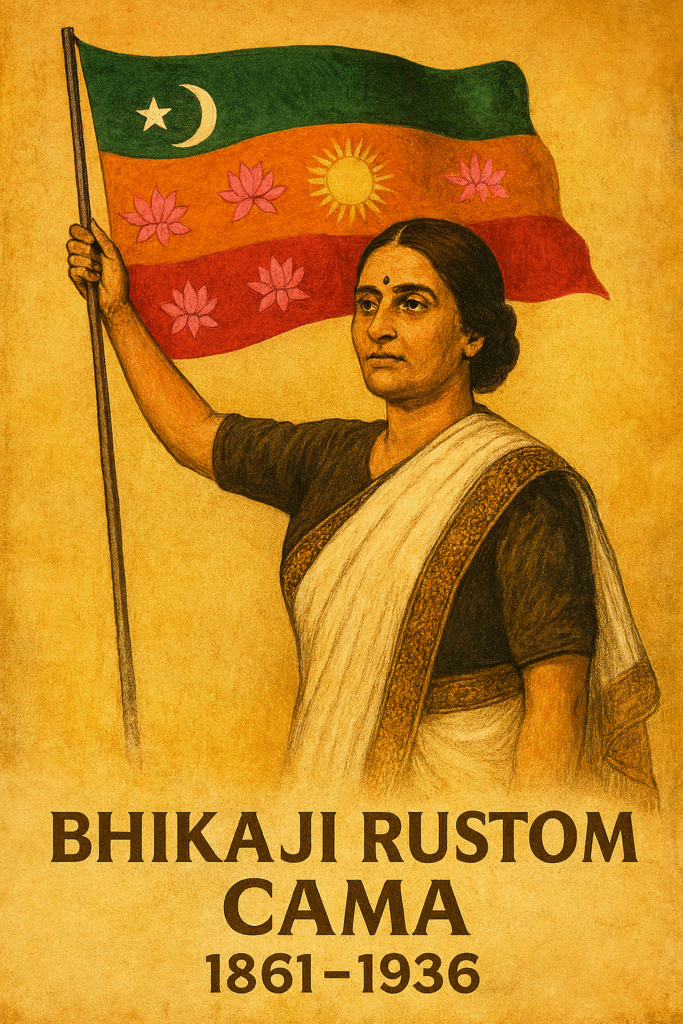
Why this title matters:
- She was among the first women to actively participate in India’s freedom movement
- She mentored exiled revolutionaries like Savarkar, Har Dayal, and Virendranath Chattopadhyaya
- She funded, printed, and distributed seditious literature that fueled rebellion
- She stood as a maternal figure in the Paris Indian Society, guiding young patriots with wisdom and warmth
“Bhikaji Cama didn’t birth a nation—but she birthed its courage.”
Her maternal role wasn’t limited to nurturing—it extended to protection, strategy, and sacrifice. She gave her wealth, her health, and her years to a cause that would outlive her.
🔶 III. The Flag That Shook Empires: First Indian to Hoist the National Flag Abroad
On 22 August 1907, at the International Socialist Congress in Stuttgart, Germany, Bhikaji Cama unfurled the first version of the Indian national flag—a moment that would become iconic in the annals of India’s freedom struggle.
The flag she raised:
- Featured green, saffron, and red stripes, symbolizing Islam, Hinduism, and Buddhism
- Included eight lotuses, representing the eight provinces of British India
- Displayed a sun and crescent moon, signifying unity across faiths
Her declaration:
“This is the flag of Indian independence. I appeal to all present to rise and salute it.”
This act was more than symbolic—it was revolutionary. It marked the first time India’s demand for freedom was proclaimed on an international stage, and it was Bhikaji Cama who carried that message.
“She didn’t just raise a flag. She raised a nation’s voice.”
Her flag inspired future designs, including the tricolor that would become India’s official emblem. But more than design, it carried emotion, defiance, and unity—the very essence of her legacy.
🔶 IV. The Global Flame: Inspiring Generations of Freedom Fighters
Bhikaji Cama’s influence wasn’t confined to one city, one movement, or one generation. Her activism spanned continents and decades, inspiring revolutionaries across India, Europe, and America.
She inspired:
- Indian youth to question colonial narratives
- Women leaders to step into political spaces
- Exiled patriots to continue their work despite isolation
- Global socialists to support India’s cause
Her reach was both ideological and emotional. She didn’t just teach strategy—she taught resilience, dignity, and vision.
“Bhikaji Cama didn’t just inspire action. She inspired belief.”
Even after her death in 1936, her writings, speeches, and mentorship continued to shape the minds of freedom fighters. Her legacy became a blueprint for resistance, a symbol of international solidarity, and a reminder that exile is not erasure.
🔶 V. The Legacy That India Forgot—Then Remembered
Despite her monumental contributions, Bhikaji Cama remained under-recognized for decades. Her name was absent from many textbooks. Her role was overshadowed by domestic leaders. Her exile became a reason for historical neglect.
But legacy has a way of resurfacing.
In recent years:
- Roads and institutions have been named after Bhikaji Cama
- Her story has been revived in academic circles and cultural tributes
- She has become a symbol of women’s leadership in revolution
- Her flag-raising moment is now taught as a defining act of patriotism
“Bhikaji Cama didn’t ask to be remembered. She made it impossible to forget.”
Her legacy is now celebrated not just in India, but globally—as a pioneer of transnational activism, a feminist icon, and a fearless patriot.
🔶 VI. Why Her Legacy Matters Today
In an age where voices are often drowned by noise, Bhikaji Cama’s legacy reminds us of the power of clarity, conviction, and quiet courage.
She teaches us:
- That freedom is a global fight
- That women belong at the frontlines of history
- That exile can be a platform, not a punishment
- That symbols matter—and must be raised with purpose
Her life is a lesson in sacrifice without spectacle, leadership without limelight, and impact without ego.
“Bhikaji Cama didn’t just live history. She lit its path.”
🔶 VII. Conclusion: The Flame That Still Burns
Bhikaji Cama may have passed away in 1936, but her legacy lives—in every flag raised, every woman who leads, and every patriot who dares to speak truth to power.
She was the Mother of Indian Revolution, the first to raise India’s flag abroad, and the mentor of generations. Her story is not just history—it’s heritage.
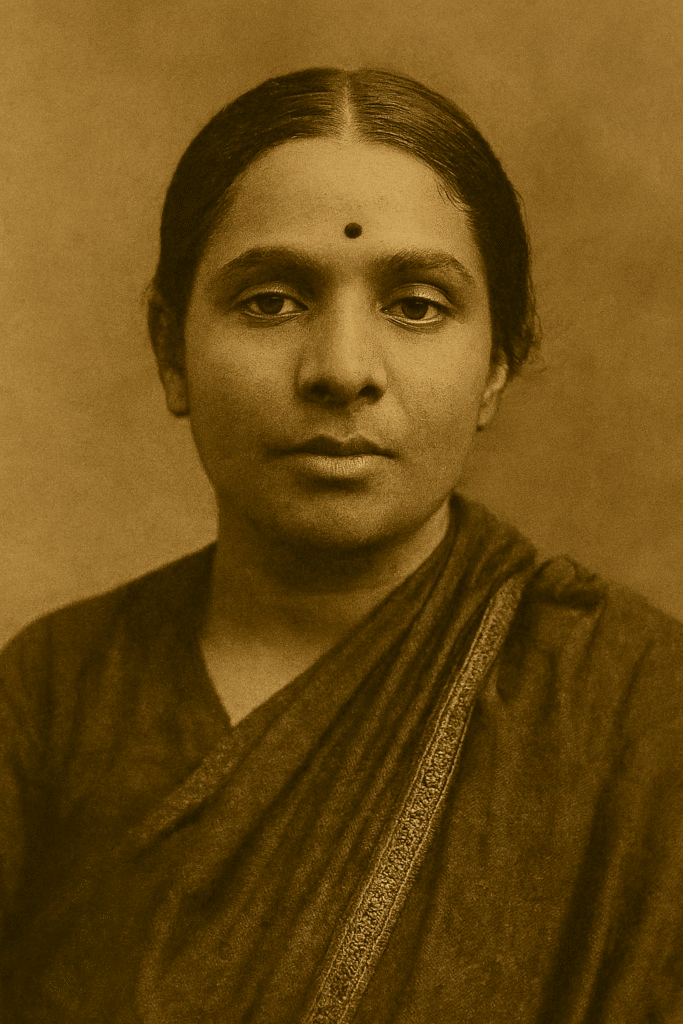
“She didn’t just fight for freedom. She became its face.”
🏁 Conclusion: Bhikaji Cama – The Flame That Lit India’s Path to Freedom
From the quiet town of Navsari in 1861 to the solemn corridors of Bombay’s Parsi General Hospital in 1936, the life of Bhikaji Cama was a masterclass in courage, conviction, and sacrifice. She was not just a participant in India’s freedom struggle—she was its architect abroad. Her journey was not defined by titles or applause, but by relentless service to a nation she could not touch for 33 years. And yet, she touched its soul.
Bhikaji Cama was born into privilege, but she chose purpose. Educated in Bombay’s progressive institutions, she grew up questioning injustice and embracing reform. Her marriage to Rustom Cama tested her ideological resolve, and her volunteer work during the 1896 plague revealed her selflessness. Contracting the disease herself, she left for London to heal—but instead, she awakened.
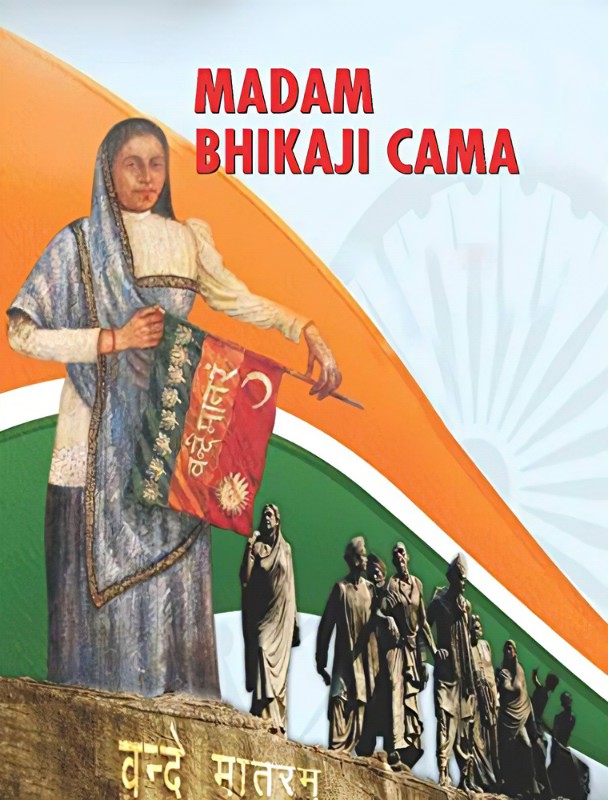
In London, Bhikaji Cama met the minds that would shape her mission: Dadabhai Naoroji, Shyamji Krishna Varma, and Veer Savarkar. She became a voice for India in exile, speaking at international forums, mentoring revolutionaries, and co-founding the Paris Indian Society. Her most iconic act came in 1907, when she unfurled the first version of the Indian national flag in Stuttgart, declaring, “This is the flag of Indian independence.” That moment was not just symbolic—it was seismic.
Between 1908 and 1914, Bhikaji Cama continued her global advocacy, building alliances across Europe and America. Despite British pressure, she remained in France, under surveillance but never silenced. Even during her house arrest from 1914 to 1935, she funded revolutionaries, preserved literature, and mentored minds. Her exile was not a retreat—it was a recalibration.
When Bhikaji Cama finally returned to India in 1935, it was under the condition that she would not engage in politics. Her body was frail, but her legacy was fierce. She passed away on 13 August 1936, buried with respect but without the recognition she deserved. For decades, her name was sidelined. But history, like truth, always resurfaces.
Today, Bhikaji Cama is remembered as the “Mother of Indian Revolution,” the first Indian to raise the national flag on foreign soil, and a global voice for freedom. Her life reminds us that patriotism is not about proximity—it’s about purpose. That exile cannot erase impact. And that one woman, armed with conviction, can shake empires.
Bhikaji Cama didn’t just live history—she lit its path. Her flame still burns in every act of resistance, every voice that dares to speak, and every woman who refuses to be forgotten.
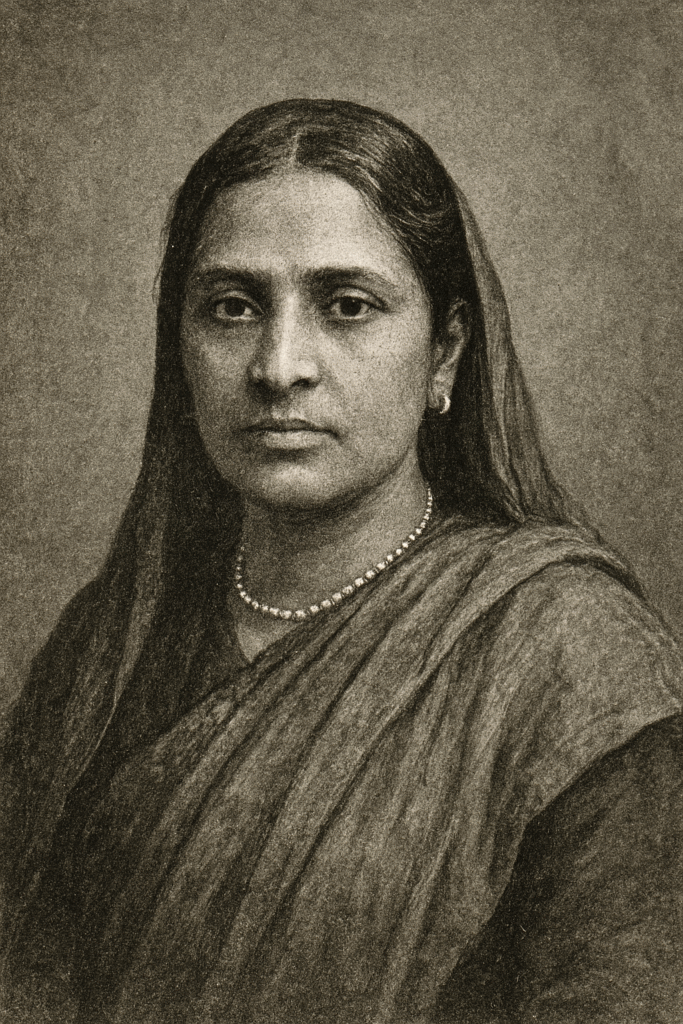
“She gave India her silence, her exile, her years—and in return, she gave it a legacy that will never die.”
📘 FAQ: Understanding Bhikaji Cama
1. Why did Bhikaji Cama choose exile over silence?
Answer: Bhikaji Cama didn’t flee India—she chose exile as a strategic battlefield. Remaining in India meant censorship, surveillance, and silence. But in Europe, she could speak freely, publish boldly, and build alliances. Exile gave her distance from colonial control but proximity to global influence. She turned absence into activism, proving that patriotism isn’t about location—it’s about conviction.
2. How did Bhikaji Cama redefine the role of women in revolution without ever leading a mass protest?
Answer: Bhikaji Cama’s revolution wasn’t loud—it was layered. She didn’t lead marches; she mentored minds. She didn’t shout slogans; she printed manifestos. Her leadership was maternal, intellectual, and strategic. By operating from exile, she showed that women could shape revolutions not just through visibility, but through vision. She redefined power as presence, not performance.
3. What made Bhikaji Cama’s flag more than just a symbol?
Answer: The flag Bhikaji Cama unfurled in Stuttgart wasn’t just fabric—it was philosophy. Each color, each lotus, each emblem represented unity across religions, provinces, and ideologies. It was stitched with defiance, dyed in dignity, and raised with purpose. It wasn’t a banner—it was a blueprint for the India she believed in: inclusive, fearless, and free.
4. How did Bhikaji Cama maintain influence while under house arrest for over 20 years?
Answer: Bhikaji Cama turned confinement into command. Her Paris residence became a sanctuary for ideas, a vault of revolutionary literature, and a quiet headquarters for mentorship. She funded movements, preserved documents, and guided young patriots—all without stepping outside. Her influence wasn’t measured by mobility—it was measured by memory, strategy, and trust.
5. What is Bhikaji Cama’s greatest legacy beyond her titles and tributes?
Answer: Bhikaji Cama’s true legacy is emotional architecture. She built bridges between continents, stitched unity into rebellion, and mothered a movement from afar. Her life teaches that revolutions need not be loud to be lasting. Her greatest gift wasn’t the flag, the speeches, or the society—it was the belief that one woman, with clarity and courage, can change the course of a nation.
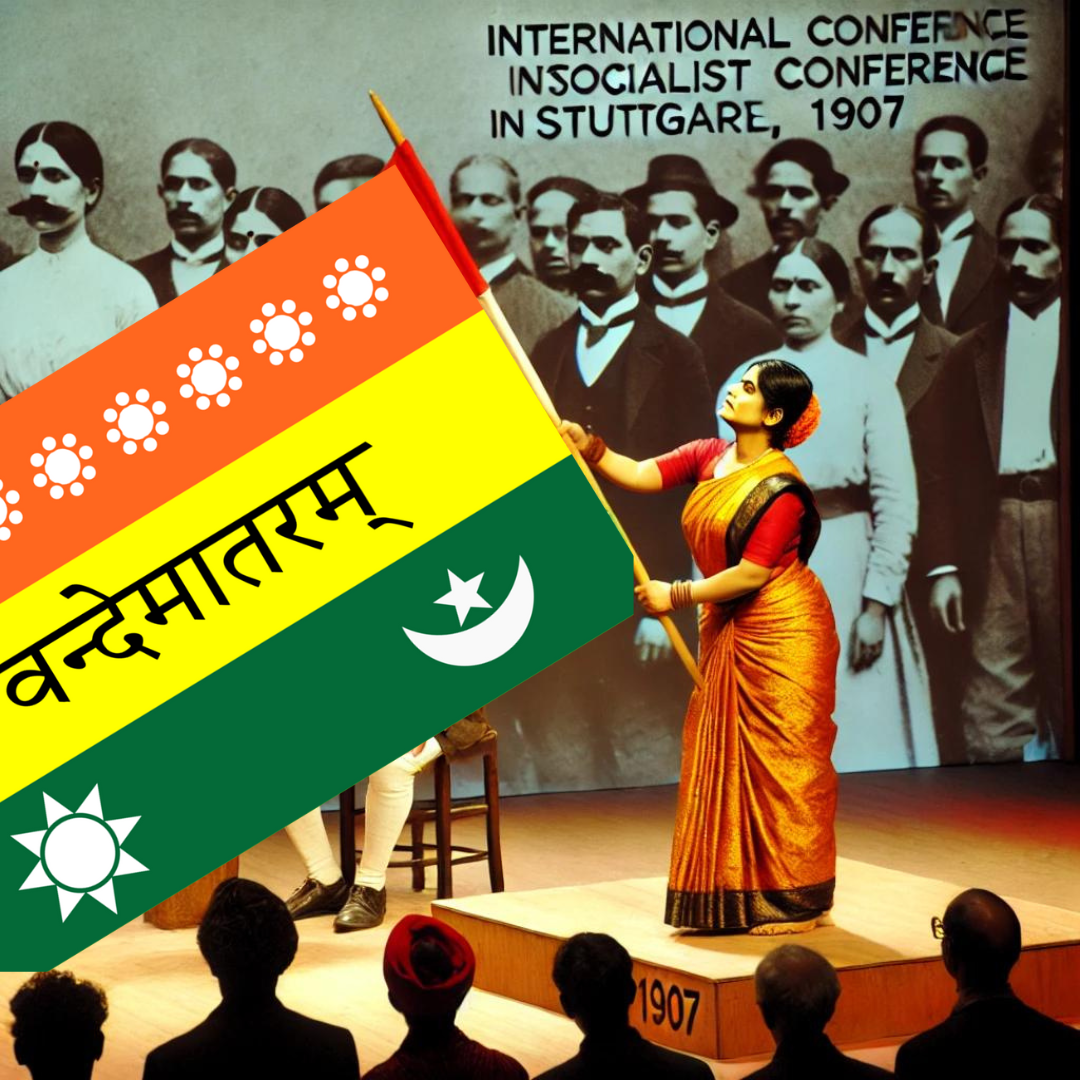
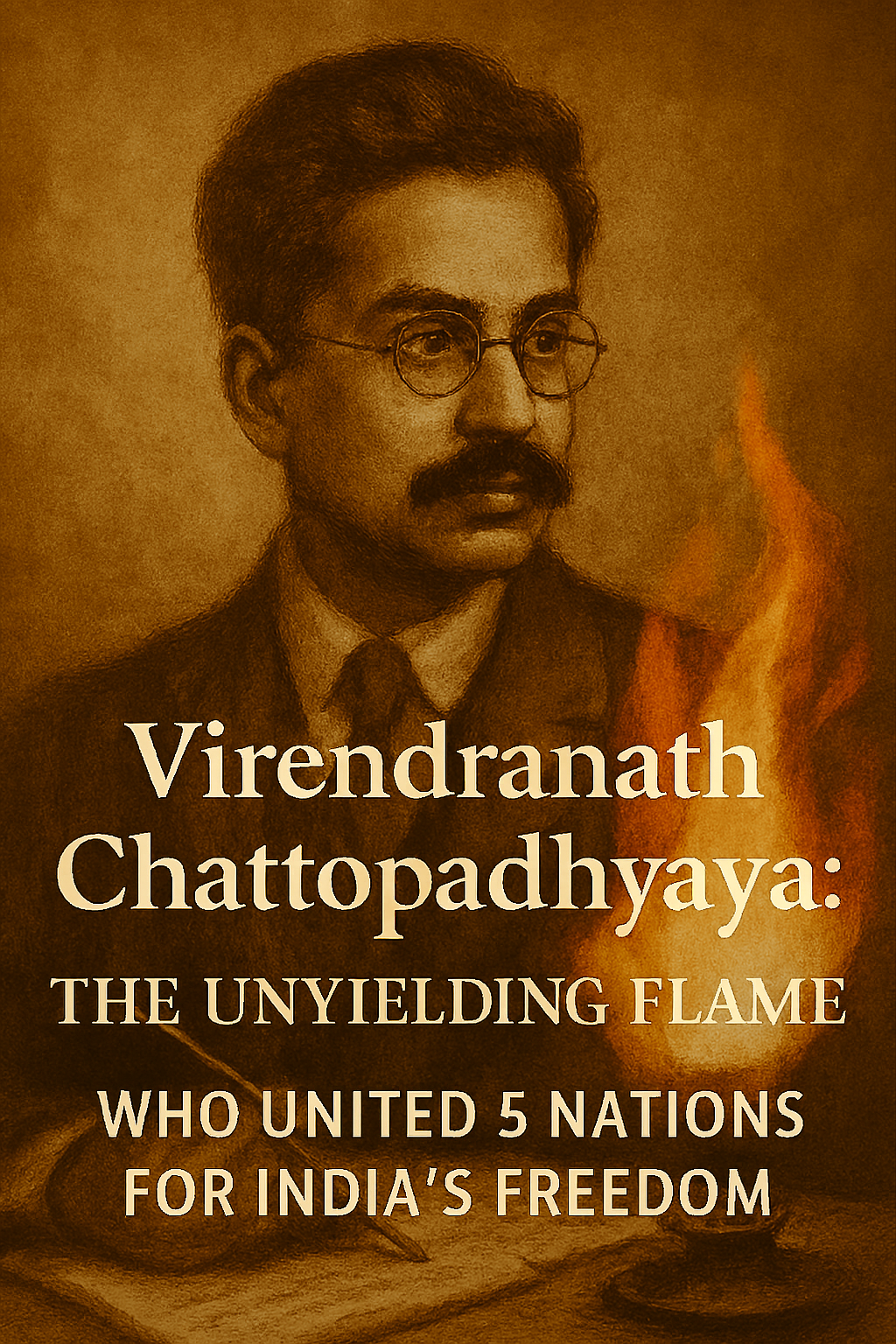
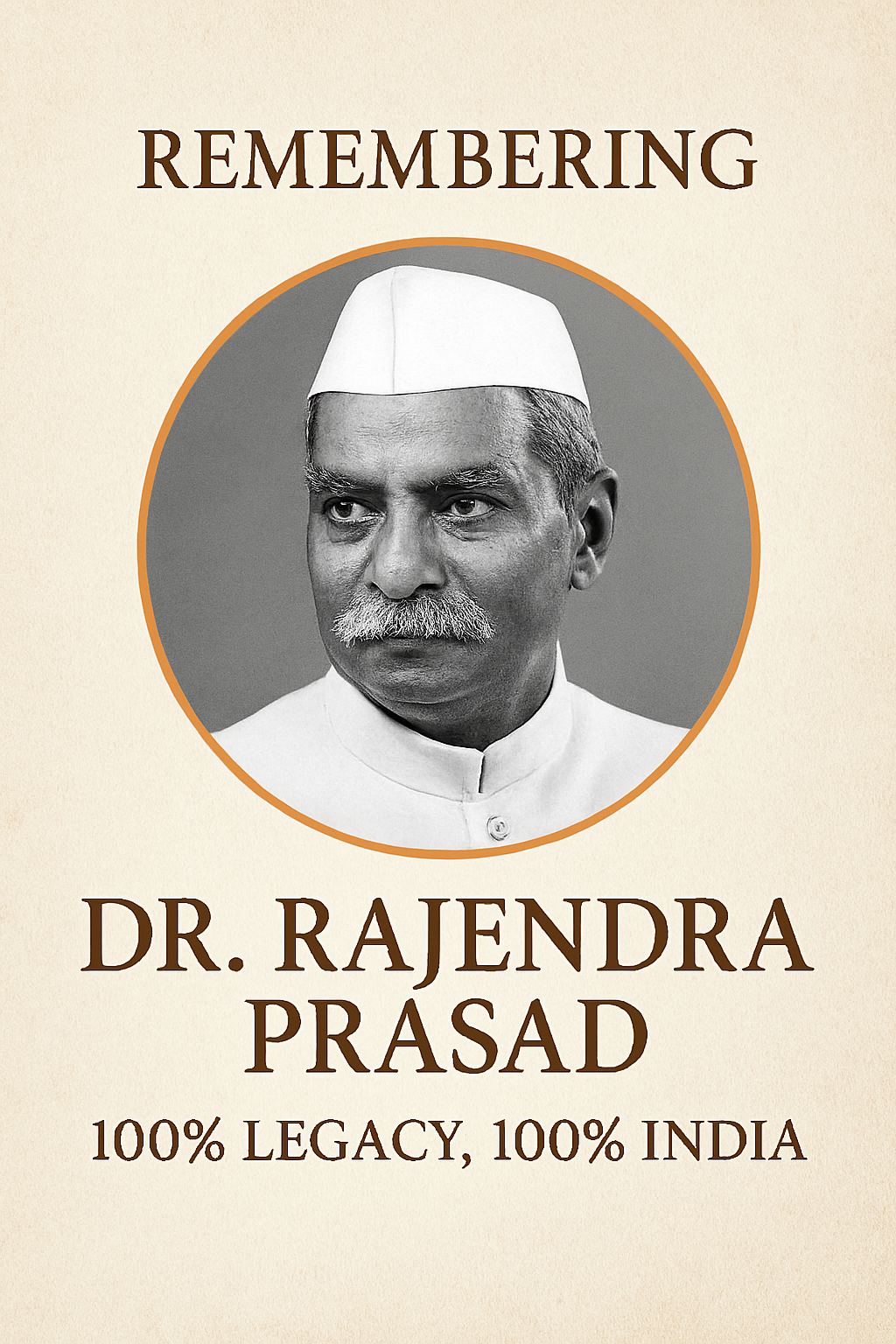
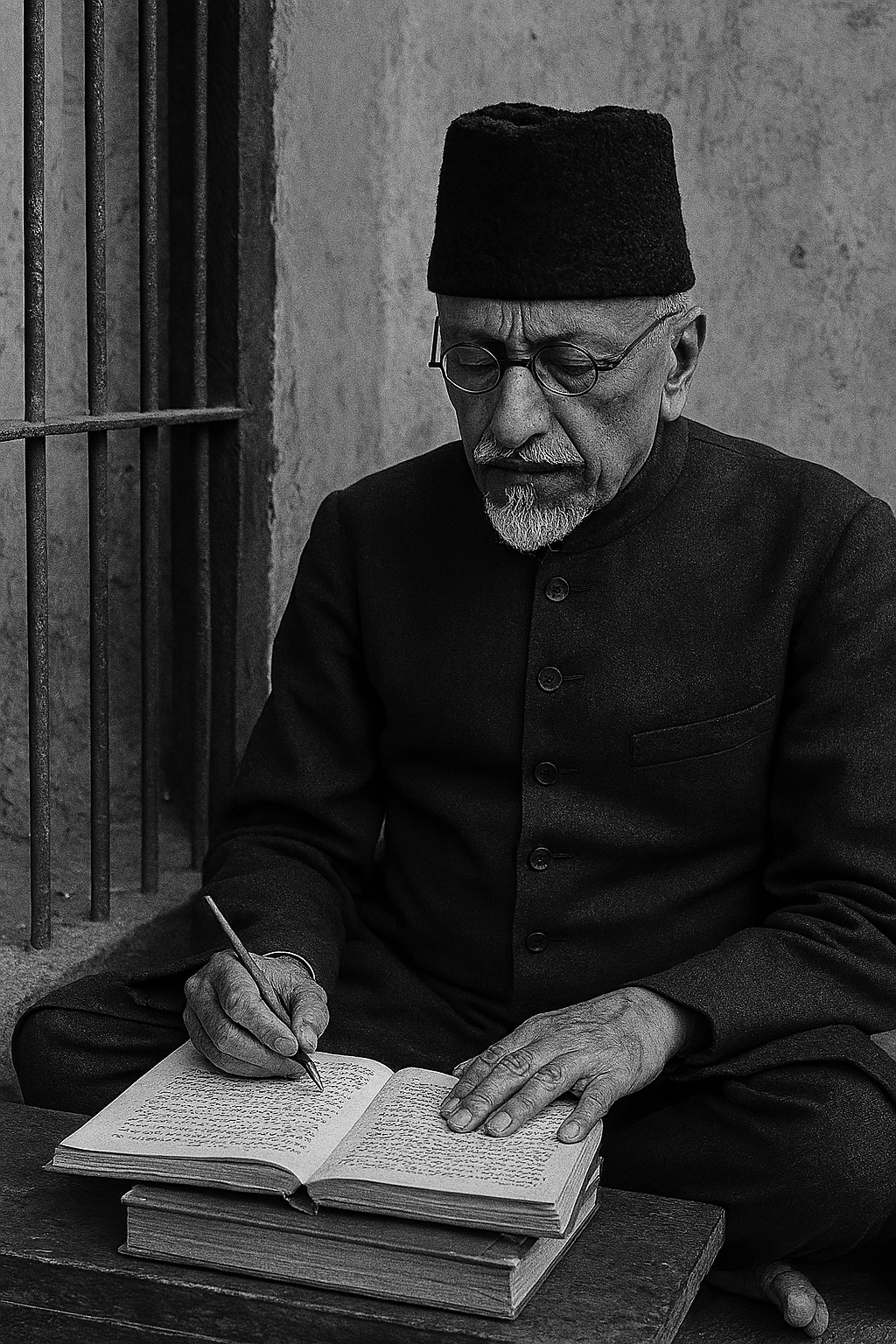
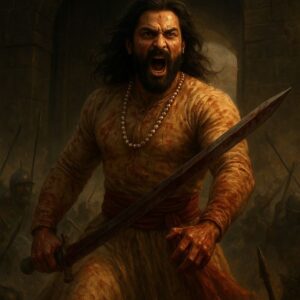
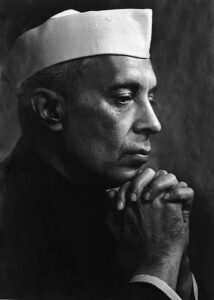
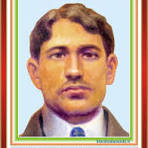
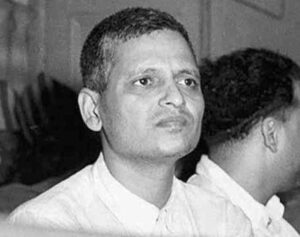
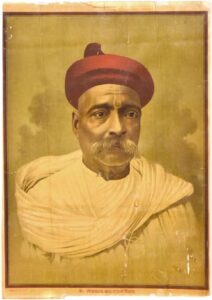
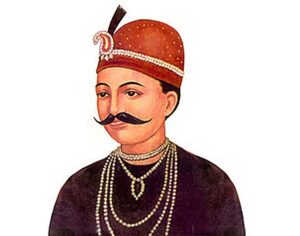
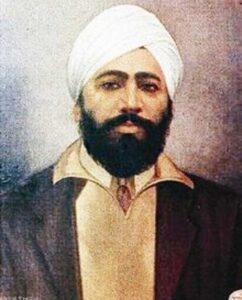
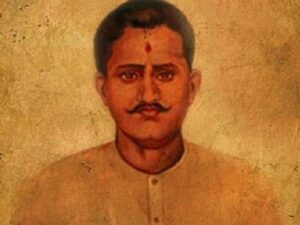
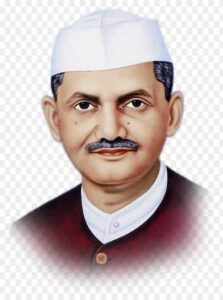
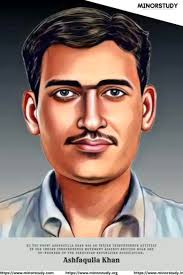
1 comment